

ALL FISH • ALL WATERS // SUMMER 2022 flyfishersinternational.org Slow Your Roll Finding strength beneath the surface Reeling in Recovery Cancer Patient and addictions survivor taking life one cast at a time MORE THAN A FEELING
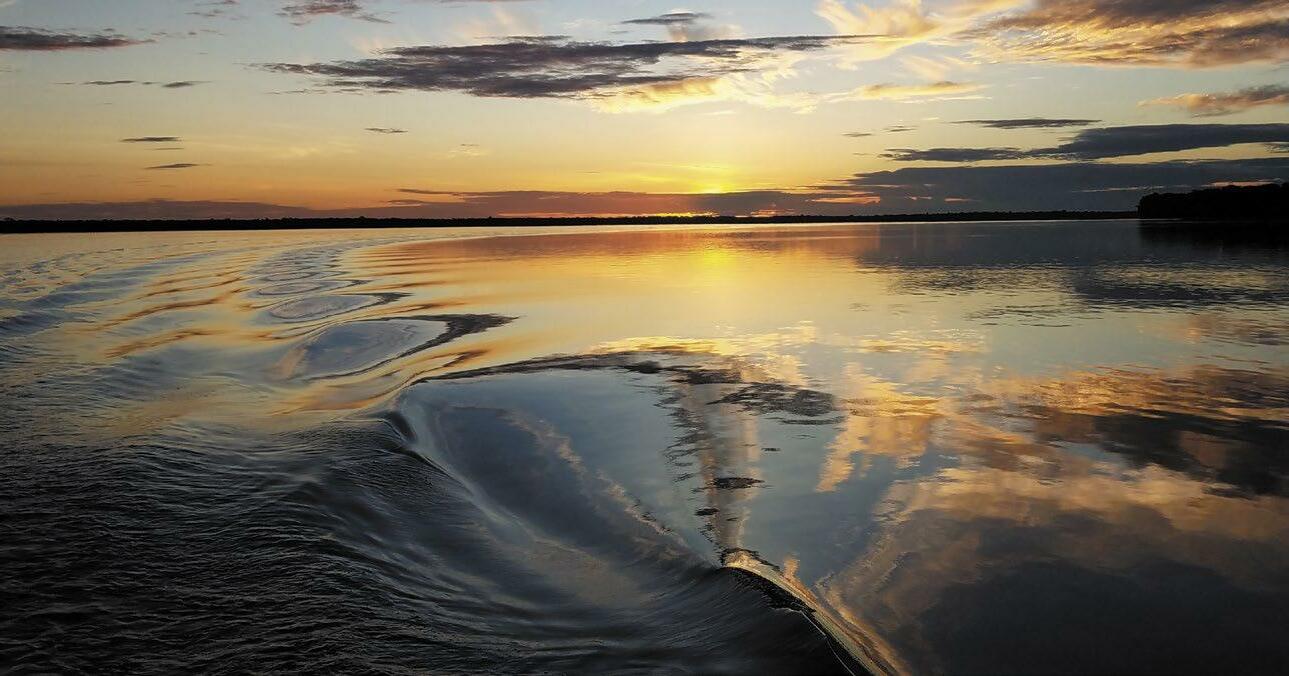





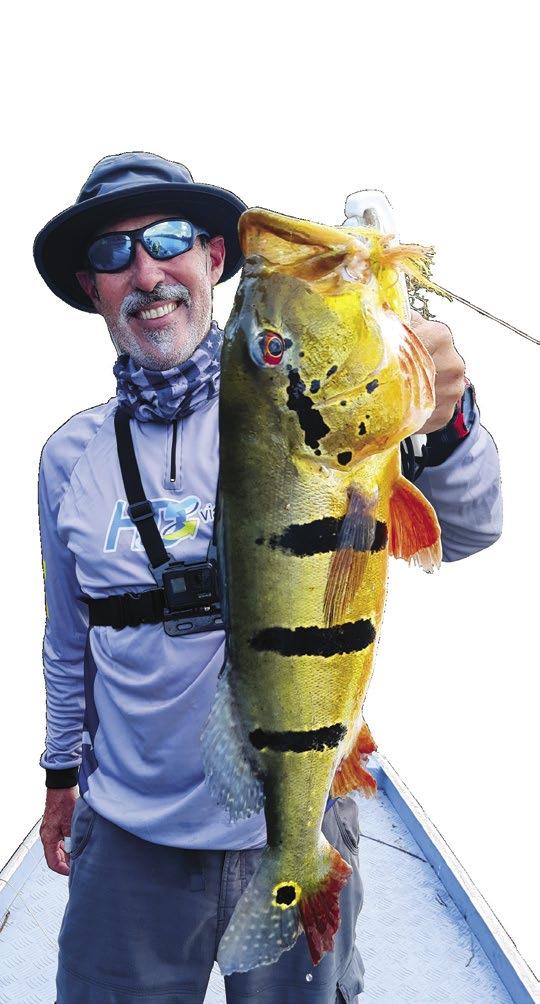
Departures October 2022 through January 2023 10% discount for FFI Members Brazil! Experience peachfishingandadventures.com peachfaa@gmail.com Book your Peacock Bass Fly Fishing Expeditions to Xeurini River, Uatumã Reservation and Juma River Also make sure to check out our off-the-beaten-path tarpon destination!
Board of Directors
Dave Peterson
Chairman of the Board
Patrick Berry (Non-Voting) President and CEO
Tilda Evans Secretary Awards Committee Chair
Jim Maus Treasurer Finance Committee Chair
John Kirk (Non-Voting) Legal Counsel
Dutch Baughman
Executive Committee Education Committee Chair
Keith Groty Executive Committee Senior Advisor
Tom Logan
Chairman of the BoardEmeritus Executive Committee Conservation Committee Chair
Jen Ripple Executive Committee
Richard Ross Executive Committee Nominations, Elections, and Board Development Committee Chair
Marnee Banks Nominations, Elections, and Board Development Committee Vice Chair
Todd Heggestad Council Presidents Committee Chair
Patty Lueken Women Programs Chair
Kuni Masuda International Programs Chair
Berry Webster Membership Chair
Bruce Williams Casting Programs Chair
Board Members
Kastine Coleman
Shalon Hastings
Chris Haunschild
Carole Katz
Geoff Mullins
Dennis O’Brien
Tim Papich
Andrew Reichardt
Berris Samples
Peter Vandergrift
Board Advisory Council
Len Zickler, Chair
Al Beatty
Gretchen Beatty Glenn Erikson
Joel Johnson
Fly Fishers International
1201 US Highway 10 West, Suite E Livingston, MT 59047 (406) 222-9369 flyfishersinternational.org
President and CEO
Lee & Joan Wulff Legacy Circle Patrick Berry | pberry@flyfishersinternational.org
Vice President of Operations
Conservation/Education Coordinator & Webmaster Rhonda Sellers | operations@flyfishersinternational.org
Communications Director Blake Parsons | blake@flyfishersinternational.org
Membership Coordinator
Presidents Club, FFI1K & Donations Kate Richardson | membership@flyfishersinternational.org Cole Hirschhorn | cole@flyfishersinternational.org
Clubs/Councils Coordinator & Fly Tying Group
Jessica Atherton | clubs@flyfishersinternational.org
Casting Program Coordinator & Merchandise Nikki Loy | casting@flyfishersinternational.org
Membership Administration Lindsey Webster | donations@flyfishersinternational.org
Bookkeeper Sharon Cebulla | bookkeeper@flyfishersinternational.org
Flyfisher is the official publication of Fly Fishers International, published two times a year and distributed by mail and online free to members. Send membership inquiries, fees and change of address notices to the FFI Headquarters at the address listed above. Flyfisher is produced for FFI by Bird Marketing Group Inc.
Editorial & Advertising Inquiries: Editorial queries are welcome and should be sent to Bird Marketing Group Inc at the address listed above attention to the Editor.

Email queries can also be emailed to editor@ flyfishersinternational.org. Visit flyfishersinternational.org for the full writer and photographer guidelines. Advertising inquiries can be directed to jbird@birdmarketinggroup. com. Visit flyfishersinternational.org for Ad rates and spec guidelines.
Reprints & Permissions
All facts, opinions and statements appearing within this publication are those of the writers and are in no way to be construed as statements, positions, or endorsements. No part of this publication may be reproduced in any manner without the written consent of the publisher. Copyright 2022 Fly Fishers International.
Letters to the Editor
All facts, opinions and statements appearing within this publication are those of the writers and are in no way to be construed as statements, positions, or endorsements. No part of this publication may be reproduced in any manner without the written consent of the publisher. Copyright 2022 Fly Fishers International.
FlyFisher
FlyFisher is published for FFI by Bird Marketing Group Inc. PO Box 227A Eastport, ID 83826
Executive Publisher Jennifer Bird jbird@birdmarketinggroup.com Editor Bob Covey bcovey@flyfusionmag.com
Group Art Direction
Terry Paulhus
Office Administrator Kim Carruthers
Department Contributors Conservation Dr. Andrew Taylor Casting Jeff Wagner Fly Tying Jerry Coviello
FFI Women Connect Patty Lueken
Contributors:
KC Badger Dutch Bauchman Dave Blair
Barry Ord Clarke
Kendra Cousineau
Josh England Keith Groty Koichi Kawai Becca Klein Gerald Lee Mike Morphew Dave Peterson Emily Rodger Phil Rowley
Lado Sakvarelidze Charles Warren Winged Reel Mark Rockwell Rick Williams Odom Wu Ramon Zabriskie
3
 On the Cover: Christian Graham
Contents: Emily Rodger
On the Cover: Christian Graham
Contents: Emily Rodger

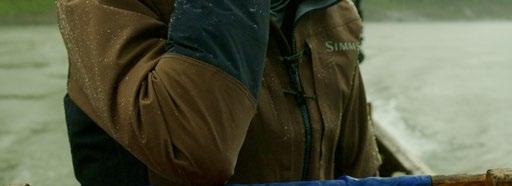
6 President’s Message Fly fishing is about more than catching fish. 8 Cycle of Life Searching out calming cadences and finding strength beneath the surface. 15 Veterans Find New Life On the water with Project Healing Waters Fly Fishing. 18 All Fish, All Waters Angler Profile Becca Sue Klein 24 Who Gives
The uncommon challenges of chasing common carp. 25 International Masters of Fly Tying 38 Conservation Fly fishing culture and conservation taking root near the Black Sea. 42 Casting Creep, drag and drift in between casting strokes. 44 Fly Tying Keying in on a different stage. 48 Fly Fishing Skills FFI Learning Center Update 50 FFI Forum News, events and happenings. 5
a Carp?
Fly Fishing
is a ManySplendored Thing
The fly fishing journey generally seems to go something like this: First, you just want to catch a fish. Then you want to catch a lot of fish. Then you want to catch a big fish. Then you want to catch a lot of big fish.
And then, if the fishing gods have smiled on you enough during your time on the water, you are happy just to go fishing (I’m still hoping I will be mature enough to achieve this last goal).
For many people in the sport, they are—and have always been—happy to just go fishing. That’s it. The fish are simply a bonus. Something we all may know directly or intuitively is that fly fishing about so much more than simply catching a fish.
There is something distinctly magical about fly fishing that transcends a finned critter tugging on the end of a line. The emotional and spiritual reward, drawn from the art, science and learning process of fly fishing, is much bigger than the gripand-grin shot that we often assume is the point of our efforts.
This philosophy has been reinforced for me many times. Most recently, it was illuminated at the 2021 FFI Virtual Expo Film Competition. The three winning films shared many traits: fantastic story-telling, incredible images and high production value, but what stuck out to me was their consistent themes; in each of the films, fly fishing is about so much more than catching a fish.
In the winning film, Becca: Water is Life, directors Justin Dobson and Matt Bornhorst show that a series of life-changing moments led Becca to fly fishing as she faced the complete unknowns of stage four cancer. She tackles the challenges with as much grace as she can muster, with two feet firmly placed in her homewaters.
The film Tightened Lines, which took second place, is an intimate, honest portrayal of a man in his 60s, Mark Roberts, who strives to get on the water, regardless of any obstacles that confront him. This emotional mini-documentary was directed by Hannah Roberts, and culminates with a reward on a level few of us will ever comprehend.
The final film, Until We Fish Together, directed by Jay Sung, tells the story of a young American boy who was taken by his mother and brought to Korea. As his father fights to get him back, fly fishing helps him cope.
And as we celebrate Women’s Fly Fishing Month, FFI is kicking off the festivities with airing of a the film Cadence. This short documentary follows the journey of Emily Rodger, a world-class professional cyclist who suffers though major injuries and accidents. Emily finds solace and healing through fly fishing. She tells part of her story in this edition of Fly Fisher. Her journey is nothing short of remarkable.
There are some excellent, inspiring organizations across the fly fishing world who recognize fly fishing is so much more than catching a fish. Many
of them are integrally connected to FFI. Project Healing Waters Fly Fishing, Casting for Recovery, the Mayfly Project, Good Fly and countless other organizations focus on the physical, emotional, mental and spiritual value of fly fishing.
Project Healing Waters Fly Fishing (PHWFF) got its start within FFI, and is now thriving as a successful organization on its own, remaining one of FFI’s most valued strategic partners. The people involved teach fly fishing skills to active and retired disabled military service personnel. By applying fly fishing as a rehabilitation tool, the organization has become recognized as an innovative leader in the field of therapeutic outdoor recreation for people who are disabled.
Many FFI members and volunteers continue to support the programs offered by Casting for Recovery(CfR). This inspiring organization provides healing outdoor retreats for women with breast cancer, providing opportunities for women to find inspiration, discover renewed energy for life, and experience healing connections with not just nature, but with other women.
The mission of The Mayfly Project is to support children in foster care through fly fishing and introduce them to their local water ecosystems. The Mayfly Project believes that engaging the children in a passion such as fly fishing can provide an opportunity to have fun, build confidence, and develop a meaningful connection with the outdoors.
Patrick Berry
Patrick H. Berry is FFI President and CEO. Berry brings over 27 years of experience within the environmental conservation field, having come to FFI from the Vermont Community Foundation where he served as vice president of philanthropy. A former commissioner of the Vermont Fish & Wildlife Department, Berry is recognized as a visionary conservationist and is widely respected by his peers.

6 FlyFisher Spring/Summer 2022 PRESIDENT’S MESSAGE
There are a variety of smaller, but equally noteworthy organizations who also focus on the value of fly fishing— the value that transcends a finned critter on the end of a line. Good Fly, based out of Texas, views fly fishing as a way to renew the mind and refresh the spirit. Good Fly focuses on fly fishing to help people deal with

depression, anxiety and stress, and offers programs to those who work in traditionally high-stress professions. Many of us are fortunate to have found our way to a passion and a pastime that does more for our mind, body, and spirit than we might always realize. The next time you are fortunate to spend time on the
water with a fly rod in hand, hoping that a big fish is willing to take your offering, remember the work of the organizations that are using fly fishing as a means to achieve more than just a grip-and-grin photo. If you let it, fly fishing will always be about so much more than just catching a fish.
7 President’s Message
Photo David A. Thompson

Cycle of Life
Searching out calming cadences and finding strength beneath the surface
Emily Rodger
Iwas 28-years-old when I competed in my first bike race. It was one of the first times in my life where I felt strong, capable, and confident. A few days later I was out for a ride when a driver ran a stop sign and hit me.
I will never forget realizing that the driver was not going to stop. I received the full impact of the SUV, flew through the air, and landed head-first on the pavement. Airlifted to a trauma hospital, there was one course of action in my mind: be strong and fight.
I embraced the fight, but the trauma I experienced during that accident haunted me for years. I put pressure on myself to be strong in everything I did, as if my life still depended on it. Along with multiple facial/jaw/dental surgeries (nine years later, I’m currently recovering from yet another one), I was also battling a brain injury.
A brave face
As I got back into cycling, people saw me as an athlete, a girl who had started riding, recovered from a near-fatal accident, and seemed to have overcome the challenges related to the misfortune. But I didn’t even feel like myself anymore—I was anxious and frustrated all the time, triggered by seemingly everything, I couldn’t think straight; I had to write notes just so I could remember what I was supposed to do next, and I was embarrassed to tell anyone how I was feeling.

I was terrified that I would never return to normal.
Emily Rodger
Meanwhile, I kept racing.
As a kid, I never dreamt of being an elite athlete. I didn’t grow up playing sports. I didn’t even realize that competitive cycling was a sport. Yet here I was, a few years after my accident and I was a two-time UCI GranFondo World Champion, Canadian Masters National Time Trial Champion and 70.3 Ironman world qualifier. I loved to push my body to the absolute max, to continually test this newfound strength I realized I had.
Cadence of connection
When I wasn’t training or racing, I just wanted to be by myself. I didn’t want anyone to see how much I was struggling. My racing success didn’t match how I was feeling inside. When not travelling for races, I was based in Arizona. On rest days I’d be in Sedona, often sitting next to Oak Creek. Sitting near the calm pools, it didn’t take long for the rising trout to catch my eye.
Seeing the trout reminded me of being a five-year-old girl, playing with my sisters, using a bucket to catch brook trout in a creek near our childhood home in New Brunswick. When I was successful with my bucket technique, I would build the fish a house out of rocks from the creek, dump them in, and watch them (seemingly) enjoy the new home I had provided for them. As a kid, the creek gave me a safe space to be myself. The activity taught me perseverance, while moments spent staring at the trout opened my eyes
Former elite athlete, avid fly fisher, and certified coach at Emily Rodger Coaching Inc., Emily was raised in New Brunswick, Canada along with her three sisters. After working as a dental hygienist, she decided to pursue her passion for triathlon and cycling. In her full first year of bike racing, she competed in 21 races, which included 17 podiums, 14 first place finishes, a National masters title, and a World Masters title in Time Trial. Emily was involved in two very serious cycling crashes where she was struck by vehicles, resulting in multiple broken bones, a brain injury, and extensive soft tissue damage. These life-altering events made her a stronger, more resilient, more grounded, and a more grateful athlete/person.
9 Cycle of Life Cycle of Life
to the beauty found in nature. Thinking back on those times as a little girl put a smile on my face. I wanted those childlike feelings of joy back—I wanted to try and catch those Oak Creek fish.

I continued racing full-time at the professional level, but my lifestyle of traveling the world for bike races now included packing fly fishing gear. Racing brought me to incredible destinations around the world. When my race schedule permitted, I would spend a couple days exploring local fly fishing holes.
Fly fishing gave me a reset. Where some athletes lay in compression boots to help drain the buildup of lactic acid in their legs, I would put on my waders and allow the current of a river to do the same. For me, cycling and fly fishing had perfectly-contrasting cadences. The slower-paced rhythm of fly fishing balanced out the high RPMs of professional racing. I felt like I finally had things figured out. After years of recovering from injuries and receiving professional help for the trauma I experienced after my accident, life now felt like it was manageable.
10 FlyFisher Spring/Summer 2022
Plans awry
Then in 2017, I flew to France to compete in my final races of the season. My plan was to return home afterward and spend my off-season on my home river, casting bombers to Atlantic Salmon before returning to Arizona. My first race went as planned, resulting in me winning my second World Championship title. Then, during my final race of the season, I was descending a mountain and came around a sharp left-hand turn to see a vehicle coming toward me on a narrow, single-lane road.

The thing I had feared most in life was about to happen again.
After I collided with the car, as I drifted in and out of consciousness, one terrifying thought kept haunting me: that I might fall asleep, only to never wake up again. I lay in that ditch for an hour and 30 minutes before an ambulance finally picked me up and drove me to a hospital that was more than two hours away.
I spent eight days in the hospital, alone, until I could fly back to Canada. I was in complete disbelief that I had been
11 Cycle of Life
struck again. Not only would my broken bones prevent me from getting back on my bike for a few months, my injuries would also stop me from spending my off-season fly fishing. Defeat was becoming an all-too familiar feeling. Fortunately, I had experience overcoming adversity.

My off-season of fly fishing did not go as planned that year, and instead of throwing bombers to Atlantic Salmon, my casting arm rested in a sling as I recovered from broken bones. I returned to racing six months later, but my desire to chase fish started to exceed my desire to chase finish lines. I made a choice to temporarily step back from racing to explore more of what was going on below the surface—both with fishing and with myself. For the first time in five years I got on a plane to travel without a bike in tow. The only gear I packed was for fly fishing.
Strength of story
When I was first approached with the opportunity to have a documentary made about my story, my immediate response was no. I didn’t think my story was worth sharing, and I also couldn’t imagine allowing others to see below the surface and glimpse the truth of who I really was. But much like how catching trout in Arizona opened my eyes and gave me perspective, I began to believe my story could do the same for others.
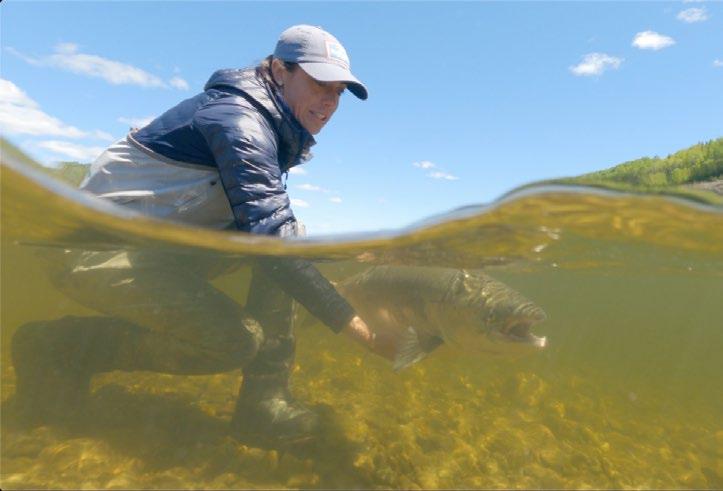

For years I hid my struggles. All I cared about was people seeing me as someone who was strong. Today, my definition of strength has expanded. Strength doesn’t only show up in athletics. Strength is when we embrace who we are. Strength is knowing when it’s OK to let go of our past. Strength is admitting we’re vulnerable.
Fly fishing has taught me to stay curious about what’s below the surface—to take a step back and see things from a greater perspective. As a little girl, those brook trout were among my first teachers of the value of perseverance, and today, fish all over the world provide lessons about being present, embracing the conditions I’m faced with and surrendering to the unknowns. There will be thousands of casts that will leave us empty handed, but every so often a cast comes back successful, showing us the worth in staying the course, even when things get difficult. My challenge to you is to keep making the next cast, even when the ones before came up empty. You never know how close you are to a breakthrough.
12 FlyFisher Spring/Summer 2022
The President’s Club at Fly Fishers International represents the highest level of financial commitment to the organization and comes with exclusive benefits and opportunities as a way of thanking donors for this level of generosity. Over the course of FFI’s history, the President’s Club has been instrumental in our ability to ensure the legacy of fly fishing for all fish in all waters. Members of the exclusive giving circle can support any program or project at FFI that most inspires them, and at a level that recognizes their level of giving, including Platinum, Gold, Silver, or Bronze.

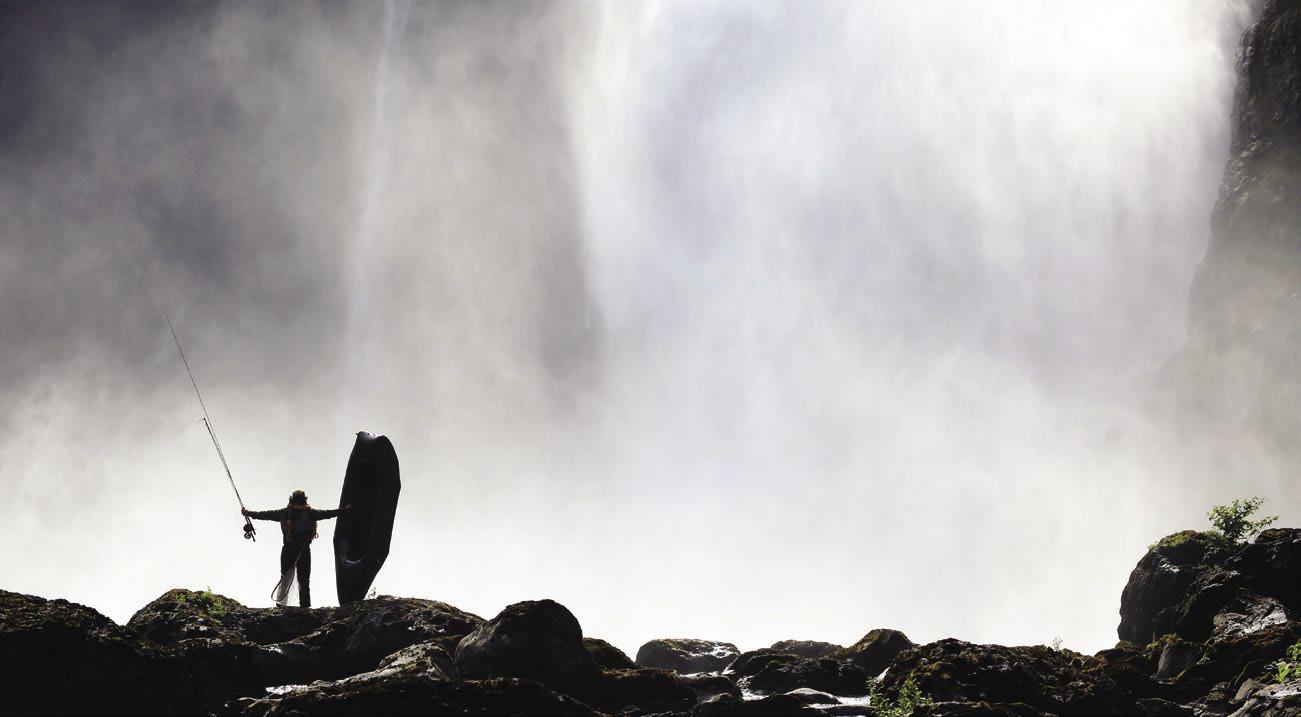
Join the Fly Fishers International flyfishersinternational.org/donate/presidents-club LEARN ABOUT JOINING operations@flyfishersinternational.org 406-222-9369 ext 4
 Photo Ed Felker
Photo Ed Felker
Veterans Find New Life
On the water with Project Healing Waters Fly Fishing
Kendra Cousineau
“You all saved my life. And I don’t say that lightly. This program has turned my life around and I want to be part of life again. I found hope on the river.” – PHWFF Participant
Project Healing Waters Fly Fishing, Inc. (PHWFF) began in 2005 at the Walter Reed National Military Medical Center in Bethesda, Maryland.
An angler’s intuition
Founder and President Emeritus, Ed Nicholson, was staying at Walter Reed in 2005, where he witnessed wounded service members returning from Iraq, and later Afghanistan. His thoughts kept returning to the peace and serenity he felt while fly-fishing and wondered if fly fishing could help the recovering and injured service members also staying at Walter Reed during that time.
After Nicholson started taking some of those patients out to fly fish, he noticed a change for the better in them, and more and more veterans wanted to give fly fishing a shot.
Mission to serve
About a year after Nicholson’s stay at Walter Reed, he started Project Healing Waters Fly Fishing, Inc. and registered it as a 501(c)(3) in the state of Maryland with a simple mission statement: Project Healing Waters Fly Fishing, Inc.
Kendra Cousineau
is dedicated to the physical and emotional rehabilitation of disabled active military service personnel and disabled veterans through fly fishing and associated activities, including education and outings.
With tremendous help from strong partnerships such as Fly Fishers International, local Trout Unlimited Chapters, and many others, PHWFF has blossomed into a project that serves disabled active and veteran military personnel from coast-to-coast, with more than 200 programs across the United States.
Collaborative camaraderie
PHWFF offers five main program activities: fly fishing education, fly tying classes, fly casting instruction, fly rod building classes, and fly fishing outings, all at zero cost to participants.
The camaraderie and the healing power that PHWFF offers to the disabled veteran and active-duty community cannot be overstated.
One statement that rings throughout the participants is “(PHWFF) saved my life.”
Kendra is a volunteer for Project Healing Waters Fly Fishing, Inc. Her love for the outdoors originated with her father taking her out fishing and hunting from a young age. In 2003, Kendra moved to Missoula, MT where she quickly realized she would have to learn how to fly-fish or risk being kicked out of Montana. She graduated from the University of Montana in 2014 with a degree in Journalism. All images courtesy of Project Healing Waters Fly Fishing, Inc
15 Vetrans Find New Life

16 FlyFisher Spring/Summer 2022
Photo Matt Romano
Natural extensions
In 2008, PHWFF introduced a fly rod building competition. A few years later, a fly tying competition followed. These competitions give participants a chance to unwind and show off their skills.
Fly tying and rod building takes a lot of concentration, but that’s exactly what these veterans look forward to.

“I am at the point where things are getting better (mentally) and PHWFF has continued to build that progress. Your mind just gets lost in the details. That’s 100 hours you’re spending not stressing. Learning the skills and little techniques…it surprised me how much I enjoyed that part as well.”- John Huffman, Shenandoah, VA Participant.
These competitions allow participants from every PHWFF program to build fly rods or tie flies as they please.
“Those rough days and nights when I can’t get on the water, fly tying has filled that void until I can get out and cast a line. Tying has not only been a stop-gap for me but has elevated my experience on the water. Having a productive day on the water with a fly that I tied has been a game changer. I no longer dread losing flies. I look at it as an excuse to tie more for the next trip.” - Alex Ward, (Ret. SPC U.S. Army) PHWFF Atlanta Participant.
The competitions are open to every PHWFF participant, and the prizes are just a bonus to the unconventional therapy.
Heartfelt honors
“I joined PHWFF just to try fly-fishing. What I found was a place that actually helps veterans heal. I have many disabled veteran friends, with brain damage or missing limbs, who I take to the hospital when needed, on fishing trips, or just to hang out. I brought them into the program and seeing them succeed in making flies and building rods does something good for the heart that I have a hard time putting into words. Add in the amazing friends I have made here, and that makes PHWFF an organization in a league of its own.”- Zachary Griffin, PHWFF Conroe, TX Participant.
PHWFF would not be successful without the help of generous volunteers and donors. In 2020 alone, while dealing with the pandemic, volunteers across the country still logged more than 255,000 hours.
“When our participants get out on the water and find themselves in the middle of a beautiful and serene situation, they don’t have to think of any demons they may have. Because you have to concentrate on what you’re doing, everything about fly fishing—from tying flies to building a fly rod and learning to cast—is very healing. ”- President Emeritus and Founder Ed Nicholson
“I can’t even begin to explain how I feel about PHWFF volunteers and if I do I usually get choked up and my eyes get misty. Thank you, everybody, from the bottom of my heart for caring enough to volunteer and be involved.” –Veteran, Maine PHWFF.
To participate, volunteer, donate, or learn more please visit projecthealingwaters.org
17 Vetrans Find New Life
Photo Daniel Morgan
For the better part of two decades, Becca Sue Klein has worked in the Waterkeeper movement. Whether in a boardroom or a social setting, she has rubbed shoulders with executives and officials, advocating for environments on behalf of the public who loved and used the resource, including anglers. But although her father was a fisherman, Becca had no real knowledge of the angling community until 2014, when The Orvis Company’s Down The Hatch Film Festival selected Chattahoochee Riverkeeper as its beneficiary organization. “That was my entrée into the fly fishing community,” she said.
Likewise, even though her career’s work helped protect different watersheds, Becca’s personal connection with the river she helped protect was limited. “I had no desire to be outdoors. To be honest, I was the girl who wore the three inch stilettos and carried the Louis Vuitton purse.”
In 2015 Becca was diagnosed with breast cancer. After a double mastectomy and a clean bill of health from her oncologist, Becca started to find herself lost. Her drinking was becoming a problem, and she was coping with her earlystage cancer diagnosis by reverting back to old, unhealthy habits. After she had a rock-bottom night, she decided enough was enough.
At the same time that her life was spiraling, by being introduced to the river she lived near, and worked for, Becca glimpsed what life might be like if she slowed things down. Through her collaboration with the film festival, she got the opportunity to pick up a fly rod. Saying yes to fly fishing was the second-best decision she ever made. Three days later, she made her best: to move forward in a life without alcohol and drugs.
Bob Covey: For some, fly fishing goes hand in hand with


18 FlyFisher Spring/Summer 2022 ALL FISH, ALL WATERS ANGLER PROFILE

19
Profile
All Fish, All Waters Angler

20 FlyFisher Spring/Summer 2022
Photo Josh England
beers in the boat or whisky around the campfire. How does Reeling in Recovery perform its work in a culture that can oftentimes seem like it’s synonymous with alcohol?
Becca Sue Klein: Since we started to promote Reeling in Recovery, we heard from people going to our website and filling out forms, talking about exactly that—the fact that there is always beer, always whiskey. It does make some uncomfortable. The Reeling in Recovery concept was to help the industry become inclusive of all people who love their local river or cove or whatever body of water you fish on. Fly fishing is about stepping in the water with a fly rod in hand. We wanted to be sort of like the Wharf Rats were to the Grateful Dead. The Wharf Rats created a safe place for Deadheads to make the decision to not drink or do drugs, but still listen to music and participate in the culture. With Reeling in Recovery, in the same way, we have the opportunity to make our industry a little more inclusive.
BC: In the context of that party lifestyle you were used to leading, where the fast pace and being spontaneous and fun and up for anything is lionized, what has your fly fishing
journey and your recovery journey taught you about the importance of slowing down?
BSK: My 12-step recovery has a motto: “one day at a time.” I never really grasped that concept until I started working in the program, until I got my advanced cancer diagnosis, and until the fly rod. Fly fishing helped me learn that because I would have to slow down my breath. I would have to approach the water in a certain way. It taught me the practice of pause.

In active alcoholism, I was always the first to react. I didn’t respond, I reacted. The concept of slowing down allows me to think before I speak, to have stronger relationships with people in my life. It allows me to pay it forward. That is a huge part of my recovery and my journey through both cancer and addiction. I might be having the worst day. I might be so in my head and upset. But if I reach out to somebody else, a lot of time that fulfills me, because I am helping someone else. So just being involved in the fly fishing community has been a huge blessing to me.
BC: How has quitting drinking and working a 12 Step
21 All Fish, All Waters Angler Profile
Photo Winged Reel
Recovery program allowed you to approach and accept your cancer diagnosis?
BSK: It laid the foundation for me. If I hadn’t worked in that program and decided to live my own truth, if I hadn’t picked up a fly rod and worked the program and had five years of sobriety under my belt, I don’t think I would have survived this cancer diagnosis. Quitting drinking and working a 12 Step Recovery program has allowed me to handle the cancer diagnosis with much more grace than I would have otherwise.
BC: You’ve had the experience of helping other people who are in recovery make that connection to nature, of showing them that they’re capable of patience and strength and learning something new. What’s it like to witness that transformation first hand?
BSK: It’s life changing. We’ve had people comment that their feelings of guilt and shame from their active alcoholism just sort of washing away in the river for that day. One woman was able to see that she could do something spiritual and heartfelt and which required focus. She could put the energy she used to give to her drinking into fly fishing. That’s the impact that a program like Reeling in Recovery can have in the community.

BC: What would you tell someone who might be surfing their own line of dangerous decisionmaking and covering up feelings of despair with alcohol, who be in a might precarious place but perhaps afraid to admit it?
BSK: I say to anyone who thinks they might have a problem or wakes up the next morning and asks themselves ‘is this worth it?’ to try sobriety. Try it. We only have 24 hours in a day. You never know unless you try. As someone who is living with a stage four cancer diagnosis, I don’t have the option to not have this disease, but I do have the option to not pick up a drink today.
BC: Our experiences make us who we are. What would you tell an 18-year-old Becca Sue Klein if you met her today knowing she had the world by the tail?
BSK: Initially when I got my stage four diagnosis I thought ‘oh my gosh, I wasted all
this time drinking and partying when I could have been doing X, Y or Z.’ But we can’t regret the past nor wish to shut the door on it. That’s what they say in my 12-step program. And so I’d tell that 18-year-old to be safe, to be smart, but to go live her life and remember that everything she goes through, there is a lesson in it all. And that’s a blessing. What else are our experiences? They are growth opportunities.
To learn more about Reeling in Recovery, please visit reelinginrecovery.org
22 FlyFisher Spring/Summer 2022
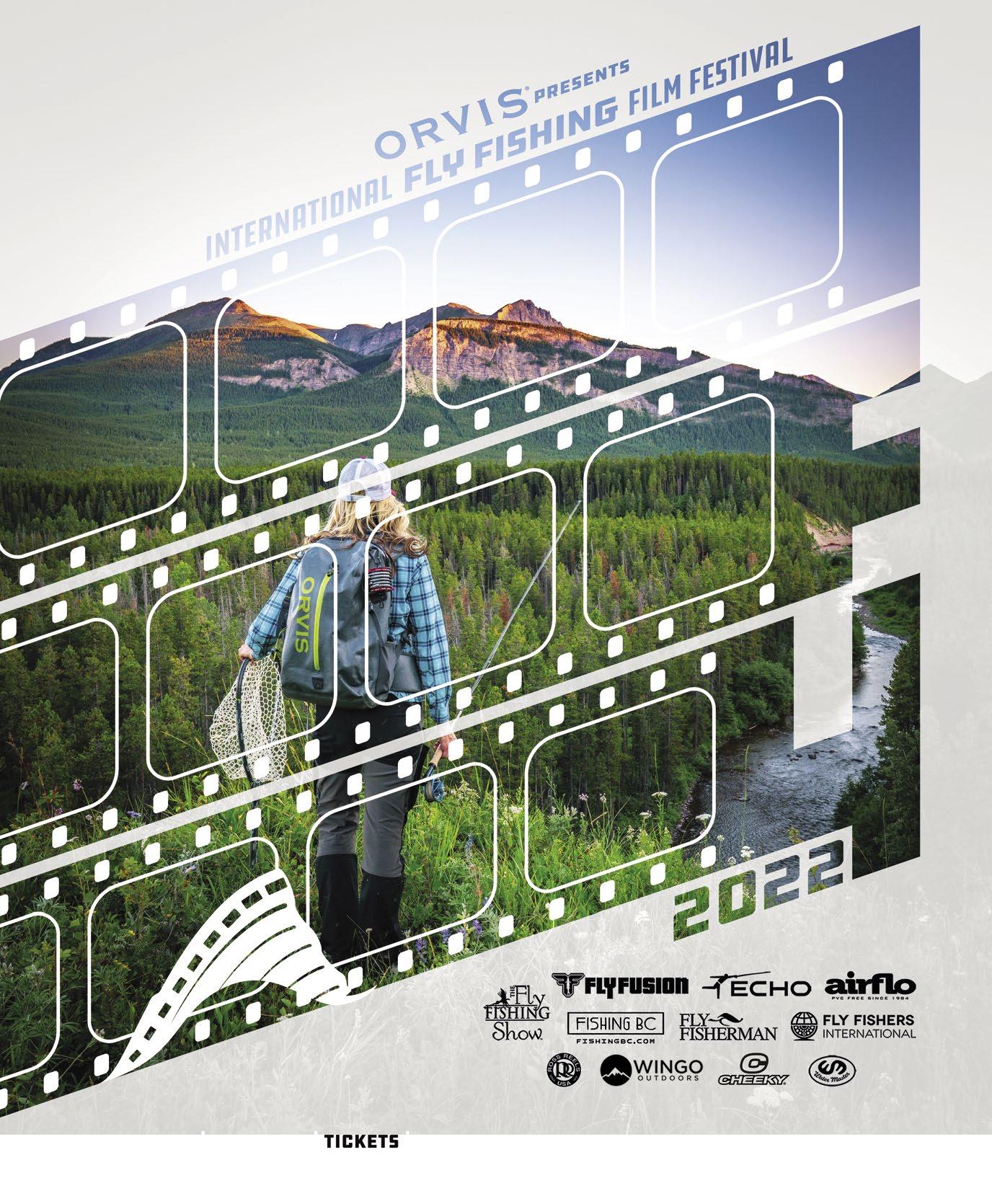


 Photo Odom Wu
Photo Odom Wu
Who Gives a Carp?
The uncommon challenges of chasing common carp
David Blair
There are very few times in our lives that we get to experience “firsts.”
Our first car, our first kiss, the first time we watched a fish come up and take a fly. That first romantic relationship may have broken our hearts, and the knuckle-busting bucket of bolts we drove in high school may be long gone, but I would argue that most of us remember our first fish on a fly rod.
The summer that I finally started catching fish on flies will forever be etched on my mind. The palatable excitement of my 16 year-old-self learning to cast to a waiting fish is something I can still bring to memory. These are the moments that instilled in us the desire to make fly fishing a part of our lives.
But while it seems as though those watershed moments are few and far between, what if I told you that, as an angler, there’s a good chance that you can have a fresh go at another “first?”
I live in the epicentre of trout country. I am mere hours away from many of the consecrated trout waters of the world. Yellowstone Park, the Snake River water drainage and the Green River in Utah and Wyoming are all within a day’s reach of me. There are also large lakes filled with salmonoids. Couple this with simple access to an
international airport and suddenly saltwater destinations, tropical flats and the most remote angling experiences are only a plane ticket away. I’ve spent the last few decades checking these places out, yet the fishing experience I’d like to share with you is probably less than an hour’s drive from wherever you reading this from. Because you’ll never forget your first carp.
Repugnant to rabid
Before you recoil at the thought of you, a dedicated fly angler, pursuing such a philistine fish, allow me to defend the common carp, a species which attracts so much enmity and faces such looks of repugnance from those who wield angling equipment. The story of my pursuit, and eventual rabid enthusiasm for carp on the fly begins a little over a decade and a half ago.
On a hot July afternoon, I found myself on the edge of a lake near my home. This natural lake is the catch basin for a blue-ribbon trout fishery and much like the Lahontan strain of cutthroat trout whose ancestors descended from the ice-age lakes of 12,700 years ago, this ancient lake was the hereditary home of the Bonneville Cutthroat. For years, this lake’s numberless 15 pound (and larger) Bonneville cutts—a cousin of those re-introduced in Nevada’s famous
David Blair
Dave Blair is a fly angler from Utah. His passion is catching all types of fish on the fly in any water that holds fish. Dave is also passionate about sharing his knowledge about the sport. He can be found spending time guiding, instructing all levels of fly fishermen and teaching bamboo rod building classes. Dave can be contacted at legacyflyrods.com.

25 Who Gives a Carp?
Pyramid Lake—smashed state records. They were large and they were legendary.
Sadly, increased human population sprinkled with poor fishery management and the introduction of what would become an invasive species, ruined this lake as a trout fishery. Early pioneers in the area introduced common carp into the lake in 1882. The carp were touted as an easy fish to farm and a good fish for the table and soon took over the biomass in the lake, outcompeting the trout. They destroyed the vegetation and habitat of the lake and eventually, the trout disappeared. Everyone in the area knew of the unpopular fish’s existence, and as I peered into the water that sunny July afternoon, acknowledging the silhouettes of these omnipresent squatters, I had an epiphany: I bet they’d take a fly.
A quick fumble through my fly boxes produced a rabbit hair streamer. I made a few casts, and, as if it were a gift from the fly fishing Gods, I hooked my first carp on a fly rod. Although I felt under-gunned with my six weight, the 15-minute battle that ensued was incredible. When I had finally wrangled it to my feet, I think I was more tired than the fish. I released it (trout angler’s instinct), and although that was the only carp that I caught that day, something in me had changed forever. A few days later, I replayed the experience to a fishing buddy. He looked at me as if I was speaking another language. We were trout anglers, salmon fisherman, hunters of the saltwater flats—this sudden keenness for carp was met with disbelief. But I pressed my point and convinced him he needed to join me. Not long after, we both had a common carp obsession.
 Photo KC Badger
Photo KC Badger
A new game to learn
We became carp junkies. We were learning plenty and eventually began to land a few fish. We discovered that carp were, at times, almost impossible to deceive with flies. They made trout seem gluttonous and careless by comparison. We had to offer different presentations, adapt our fly patterns and figure out their different feeding habits and where they held. We had to learn how to read water in a completely new way. It was as if we were learning a whole new game, and it was as challenging as it was exciting. Perhaps the most appealing of the process was that we had the fishery all to ourselves; this was in the middle of the summer, but for us the normal doldrums that come at the hottest time of the year was replaced with renewed excitement. We were experiencing that “first thrill” feeling all over again.
While some turned up their nose at the thought of fishing for carp, I was amazed to discover that there were a few anglers in the fly fishing community who had a great deal of respect for this fish. Lance Egan and Dave Whitlock, to my surprise, were among the first few fly fishers who embraced this fish as a worthy opponent. Both of them had been carp fishing for quite a while and I soon learned that my “epiphany” was hardly unique. The “Egan Headstand” fly was already known in the carp world, and as had already been discovered by many saltwater anglers, because carp often behaved like a spooky bonefish on some exotic flat, our own backyard suddenly became the training grounds for the next trip to the saltwater.
We began stalking them in the flats of the lakes in the West. We cast to them feeding in large river systems where they had escaped from upstream reservoirs. We searched every back-water slough in our adjacent states. These powerful, under-appreciated fish were everywhere. We caught them on chironomids under indicators. We cast to feeding schools with San Juan worms. We discovered that carp often lined up to “cloop” on spent lake midges in the foam lines created by the wind in the evenings. We cast Semi-seal leach patterns to them, and to our delight they ate them. A fellow angler and fly tyer began to dabble in different patterns that would potentially entice a strike from these fish that lived in our local duck ponds. We chucked bread flies, algae flies and flies that resembled popcorn and Cheetos. It seemed as though I was 16 again. I was discovering fly fishing for a second “first time.”
Side-eyed suggestions
It wasn’t everyone’s first time. Compared to some, I was late to the carp game. But as someone who saw the light, I want to let you in on a few tips and tricks that I’ve learned. Just be careful who you share them with. They may look at you a little side-eyed. These are difficult conversations for fly anglers who have an inherent trout bias.
When it comes to water temperatures, carp like it hot. This is a good thing. We could discuss how climate change is affecting our watersheds, but without getting too political, I will say that giving our trout a break in the hot summer months to pursue another species is beneficial. Catching trout in water that is too warm and thereby less-oxygenated is not healthy for the fishery. This, alone, is a good reason to angle for carp. They love the warm water, becoming most active in water that is above 75 degrees Fahrenheit. Fishing for carp is also a great reason to use that 8 weight rod that you don’t get to pull out of the storage closet between trips to the ocean. If you don’t have an 8 weight, well here’s your excuse to add to your arsenal. While you’re at it, get a good saltwater reel with a legitimate drag. These fish will put you into your backing. They will make runs that will actually test the drag on your reels. They may not be fast, but their power is like that of a red fish or black drum on the flats. Occasionally, they even jump. And while carp certainly love the warm water, we have discovered that they will take a fly every month of the year. If there’s open water, and carp inhabit the fishery, you can (theoretically) land them.
So you’ve got your rod and reel, what’s next? A weightforward floating line is paramount. While not essential, because of the temperature of the water, a tropical bonefishstyle floating line works best. Trout lines seem to wilt in the heat, although one can certainly make due. Connect to your line a high quality, seven-and-a-half-foot tapered leader of simple monofilament. Usually 2X will be light enough, but I sometimes go with 3X. Keep in mind that carp have a tendency to stay down in the areas where they feed, and will break you off on rocks, submerged tree branches and whatever else they can find. Whether you prefer to mitigate that risk with a 1X leader or offer a more subtle presentation with 3X is up to you, but keep their spookiness and their fussiness in mind. Carp are clever!
Made for stealth
As mentioned, the original carp transplants were to be the answer to an easy and tasty food source. That idea never
27 Who Gives a Carp?
really caught on in most parts of North America, and one of the arguments against these fish as table fare is their bony nature. It’s true. Carp have a lot of bones. But for anglers, this makes them even more sporting—they have an incredible ability to feel movement. There is a section of “Y” bones above what would be a primary lateral line on most fish, and it’s my opinion that this explains why they are so sensitive to being snuck up on. If you’re loudly clomping around the flats looking for fish, they will leave town in a hurry. If you boot a rock or snap a branch along a trail on a carp fishery, they’re gone. Unlike trout, if you spook a carp, oftentimes they don’t come back to feed in the same area for hours—sometimes days. These fish are adaptable. Many of them live in murky or stained water. Don’t let that fact fool you into believing that they can’t detect you. While they may not see you, they can feel vibrations better than most fish. Stealth is critical. But this only adds to the challenge and fun in angling for these fish.
Bright sun (along with glare-reducing polarized glasses) is another important factor when fishing for carp. Similar to saltwater angling for gamefish, blind casting to water that you’re not sure holds fish is usually a waste of time. Sight fishing to carp is not only more exciting, it’s much more efficient. Another consideration is whether or not they’re spawning. While they are easy to locate when the spawn is on, actively spawning carp usually will not eat. It’s also a good time to leave them alone.
At other times of the year, carp may be difficult to locate. Most often you will see an underwater “dust cloud” as a fish zooms away after you’ve spooked it. Don’t let this experience deter your efforts. Instead, use it as an opportunity to
learn from the fish. Why was it there? Was it in a specific depth of water? What was it eating? This might be tough to narrow down as carp will eat almost anything, but some days carp will eat almost nothing—or at least nothing you are offering them. This goes back to my point of the fun and difficulty of figuring out the habits of a new species of fish. Carp are opportunists. They will eat cottonwood seeds that alight atop the water, they will eat mulberries that fall into the stream. Crayfish, freshwater clams, worms, beetles, grasshoppers and small minnows are common forage for Carp. A productive carp angler will think outside the box. I’ve even cast glow bugs and other “attractor” flies.
Mixed menu
Despite their dietary diversification, carp mostly feed on the bottom. They are like vacuum cleaners when they feed. I’ve often seen huge “muds” on large reservoirs where schools of carp are moving like a herd of plains animals over the area. This is another somewhat similar trait to bonefish or redfish. They don’t often chase down food, but as I have discovered, carp will track and grab a slowlystripped leech pattern. They will also follow a bounced, slow-stripped bonefish fly. A well-stocked fly box should include a combination of various bead chain and lead dumbbell-eyed flies. The typical strategy of fishing darker fly patterns in more-stained water is likewise effective for carp. My favourite colours are black, olive and purple—with a healthy mix of chartreuse and yellow.
A large carp inhales its food. I’ve observed what appears to be about a quart of water sucked into the mouth of a carp as it eats. While this may sound like an aggressive eat, the
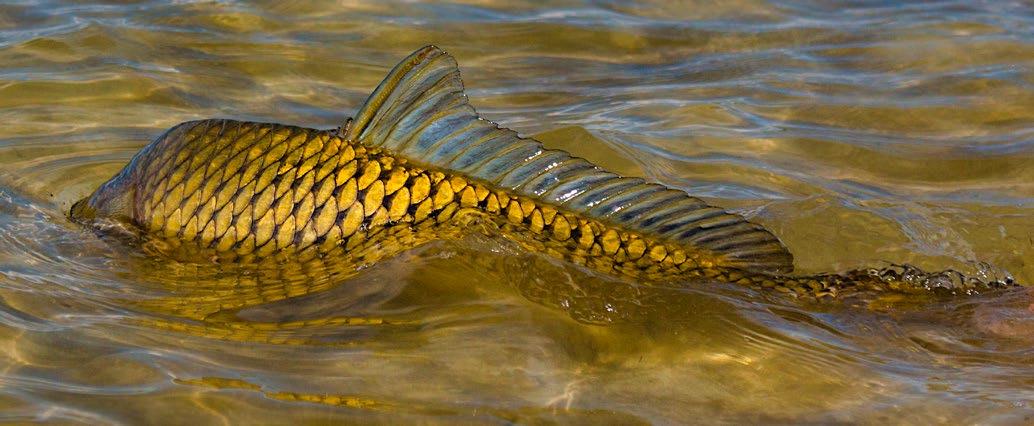
28 FlyFisher Spring/Summer 2022
Photo Ramon Zabriskie
resulting impact on the fly is in fact very subtle. A quick hook set before the fish expels the water is important—and challenging. This visual element is one of the most exciting aspects of carp fishing. If the water is stained, the fish will tip up its tail, a la bonefish or redfish, and because the take is so subtle, the angler has to anticipate the fish’s feeding behaviour as they prepare to strike. Proper anticipation will result in a proper hook up (a quick note about hooks: large gape hooks and heavier hooks are a must. Trout fly hooks easily bend out.).
When all the stars align and conditions are just right, carp can be found feeding on top of the water. Carp take surface bugs (or seeds or berries) in a style described as “clooping.” When I first saw this behaviour, I thought the school of fish were taking in air like a tarpon or an arapaima. After closer observation, I realized that they were feeding on spent midges or mayflies that had reached the spinner fall stage. Imagine when I discovered that I could catch 15-to-20pound fish on dry flies? This opened up a whole new chapter in my carp fishing saga and soon, adapted Wulff patterns, hoppers, foam beetles and other concoctions started coming off the vises of my friends and I.
It has been my experience that a carp swimming just under the surface, moving quickly, is not likely to take my fly. Most carp feed slowly, and those fish that are moving otherwise are probably heading to new grounds on which to forage. Fish behaviour, especially with carp tell us a lot about their habits. Much like the highly-described feeding
habits and seasonal diets of trout, anglers have a whole world of things to learn from the common carp.

Earning respect
The debate over whether we should eliminate carp from North America is one that I choose not to engage in. The fact of the matter is the carp’s ability to adapt is linked to its ability to stay. While I consider myself primarily a trout fisherman, I’m an angler first, and I can find a lot to love about the common carp. Carp are fighters. Carp are adaptive residents. Carp also seem to be finally getting the respect they deserve by North American gear anglers. Organizations like The American Carp Society (ACS) have done well to introduce to the U.S. the value of this oncespurned fish. The ACS promotes catch and release for these fish, encouraging respectful handling and treatment of the common carp. The ACS also includes a section in each of their publications dedicated to anglers pursuing carp on the fly.
My new perspective on an invasive species came from discovering how sporting they can be to sight, stalk and sleuth. If you haven’t already and you, too, want to discover a fly fishing “first,” consider chasing carp. Once you’ve hooked up to one of these heavy, powerful and capable combatants, you might never look at trout the same way again.
Dave Blair is a fly-fishing guide, instructor and bamboo rod builder who lives in Utah. He owns Legacy Fly Rods, and can be found at www.legacyflyrods.com
29 Who Gives a Carp?
Photo Gerald Lee

Proven patterns from four seasoned tiers hailing from all corners of the globe 30 FlyFisher Spring/Summer 2022
International Masters of Fly Tying

31 International Masters of Fly Tying
Illustration: James Dunlap @dun.and.dun dunanddunshop.com
The Evolution of Balanced Flies
By Phil Rowley
Iam forever thankful to Gerry McBride from the Inland Empire fly fishing club in Spokane, Washington, for developing the balanced fly concept. Jerry’s original idea has had a significant influence on my fly designs.
A standard, down-eye hook was the original balanced fly foundation. A tungsten bead was slid onto a trimmed sewing pin and lashed onto the shank, forward of the hook eye, before tying the fly. When suspended under a strike indicator, the finished fly hangs horizontally.
I have since swapped the down eye hook with an up eye, 60- or 90-degree jig hook. This practice eliminated the risk of accidentally obscuring the hook eye during the tying process, making it difficult, if not impossible,

to tie the fly onto your leader. A short, tapered, sequin pin replaced the trimmed pin, eliminating the risk of severing the tying thread on the ragged cut end. This foundation remains the cornerstone for most of my balanced flies using 1/8” (3.2 mm) or smaller tungsten beads. I use small brad nails or escutcheon pins, featuring a larger head. The larger head prevents the bead from sliding off—an issue when using larger beads. If you are using a larger bead, keep in mind larger beads are heavier, and therefore challenging to cast. Whenever possible, I prefer to keep my bead size to 1/8” (3.2 mm) or less.
Newer tungsten bead options have also influenced how I tie my balanced flies. Depending on the pattern, slotted tungsten or teardrop-shaped Head Turner beads eliminate the need for the pin extension.
Slotted tungsten beads are ideal for smaller, compact, balanced flies such as micro leeches. Heavier, tear dropped-shaped Tungsten Head Turner beads allow
32 FlyFisher Spring/Summer 2022
you to balance flies using other hook styles, including standard shank and curved scud hooks.


When using Tungsten Head Turner beads, slide the bead onto the shank, with the concave side facing forward. This practice places most of the bead’s mass ahead of the hook eye, helping to balance the fly. Tear dropped tungsten beads are 20 percent heavier than slotted beads as the drilling process removes less material.
When using traditional balanced flies, I use a nonslip loop knot. Using a non-slip loop knot on a pattern tied with a slotted or Tungsten Head Turner bead causes the fly to suspend at an angle. Sometimes fly position is inconsequential, but I believe a horizontal profile works best.
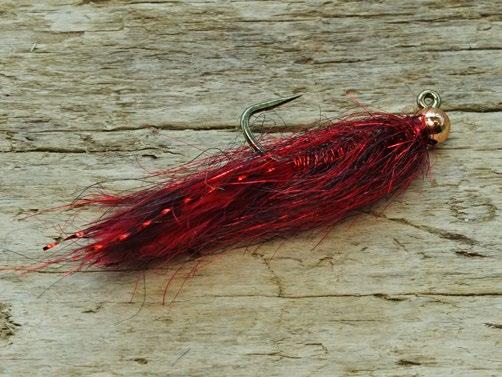
A clinch or improved clinch knot is the key to presenting patterns featuring slotted or Tungsten Head Turner beads horizontally. With the knot cinched tight, manipulate the leader or tippet so the knot seats just past vertical at the 11 o’clock position. You will have to periodically re-set the fly, especially after releasing a fish, but your flies will suspend horizontally, just like a traditional balanced fly.
Baby Leech-Bruised
Hook: Daiichi 4640 #12
Thread: Black
Tail: Schlappen flue from the base of the feather, Black Mixed with Crystal Flash, U.V. Pearl
Body: Arizona Simi-Seal, Black/Blue spun in dubbing loop of size small blue Ultra Wire
Bead: Slotted Tungsten, 7/64” (3.0 mm), Gold, Fl. Orange or Fl. Chartreuse
Balanced Leech-Bruised
Hook: Daiichi 4640 #10
Thread: Black
Tail: Marabou, Black Mixed with Flashabou #6904, Ice Blue
Body: Arizona Simi-Seal, Black/Blue
Bead: Tungsten, 1/8” (3.2 mm), Gold, Fl. Orange or Fl. Chartreuse
Extension: Gold or Silver Sequin Pin
Micro Leech-Bruised
Hook: Daiichi 1120 or 1530 #12-14
Thread: Black
Tail: Schlappen flue from the base of the feather, Black Mixed with Crystal Flash, U.V. Pearl
Body: Arizona Simi-Seal, Black/Blue Bead: Tungsten Head Turner, 7/64” (3.0 m), Gold, Fl. Orange or Fl. Chartreuse
33 International Masters of Fly Tying
Hyper Realistic Imitations
By Mike Morphew
Iwas first drawn to the art of tying as a boy in the UK. At a fly fishing exposition I remember watching a tying demonstration for hours until my father finally pulled me away. Just before we left, the gentleman motioned me over. To my delight, he gifted me his half-empty packs of tying materials. It felt like Christmas morning! Soon I was tying my first fly, gripped in a pair of needle nosed pliers which were themselves clasped in a woodworking vise. I later found out that the tyer was the legendary John Veniard. Later in life, while starting up a Fly Dressers Guild club, I was lucky enough to become friends with the prolific author.
An educator in my working life, I love teaching. The passion carries on into my fly tying career; I have spent countless hours at shows and clubs, instructing the art of dressing a hook and demonstrating skills for both beginners and proficient tyers—from setting a dry fly wing to creating the simple wooly bugger. Even after more than 40 years of tying flies and fishing for trout, salmon and saltwater fish, I still get a thrill from seeing a youngster’s face light up after tying their first fly.
I became interested in tying ultra-realistic patterns about 15 years ago. These flies and bugs are a huge hit among attendees at expositions, both here in Texas, where I hang my hat, and at shows I have attended around the U.S.
Although I’m not typically using them to fish (I mostly tie them for clients who mount them or put them under a glass dome), I have found tying these super-detailed patterns helps me with thread control. That control comes in handy when tying any other fly—from simple trout flies to fullydressed salmon patterns.
Another experience of a lifetime was in 2003 when I presented, whilst living in the British Virgin Islands, a fully dressed salmon fly to Her Royal Highness Princess Anne. I have also been humbled to be awarded the Gold certificate for the FFI tying awards.
Since moving to the quaint historical town of La Grange, Texas, I have had to adopt my tying and fishing for bass and bluegill. I have loved the challenge but still miss my trout and to that end every year travel to Oklahoma and Arkansas. The following patterns are a few of my favoriteshopefully they will get you into some fish.
Davy’s Floating Shad
A fly devised by my good friend Davy Wotton to imitate a dying shad, this fly has accounted for numerous bass during spawning. At that time the water erupts as the bass hit shoals of shad. Cast it into the disturbance and the bass will rise to it like a dry fly, fantastic sport! Davy’s Floating Shad is also great for enticing big browns in rivers like The White.
Materials: Hook: any wide gape, long shank size of your choice.
I have used a size 4. Thread: UTC white 70
Body: ¼ inch mylar tubing in pearl is the best Tail: white marabou

Eyes: real eyes (size to suit your hook choice) Gills: red wool
Over body: strip of white closed cell foam
1. Place the hook in the vise and add a few turns of red wool behind the eye to represent gills.
2. Select a piece of white marabou and tie in as a tail, about 2/3 the shank length.
3. Cut a length of the pearl mylar a little longer than the hook shank. Attach your tying thread at the bend of the hook.
4. Slide the mylar over the hook eye and down to the thread, then tie in a strip of white foam. Tie the end of the mylar and whip finish.
5. Tie the thread on again at the eye and tie in the mylar. Gently push the mylar towards the tail to form a fishshaped belly. Tie it off at the eye and trim the excess. Add a little superglue to the underside of the foam and pull it over the top of the body; whip finish.
6. Select a pair of eyes and glue just behind the eye of the hook.
34 FlyFisher Spring/Summer 2022
Materials:
Hook: any longshank size 10

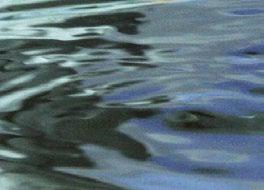
Thread: white UTC 70

Underbody: section of florists wire built up with foam strips
Body: blue Raffine or Swiss straw
Legs: black broom bristles
Thorax: foam and blue Raffine

Eyes: pearlescent plastic beads wrapped in organza
Wings: actual wing photographed and laser printed onto acetate sheet. Cut to shape then scored with a needle and lightly colored with a blue Copic pen
ALL FISH, ALL
SAVE THE DATE November 4 - 6 35 International Masters of Fly Tying
Blue Dragon Fly
WATERS ®
CDC: Versatile & Aero-Dynamic
By Barry Ord Clarke
There are many different parachute hackling techniques, both traditional and some more contemporary, but there are few which employ CDC (Cul de Canard, or duck bottom). Because of the unique floating and aerodynamic qualities of CDC, I was looking to develop a parachute hackle that would resemble, perform like, and retain a comparable presentation to that of a traditional parachute hackle. My initial objective was to avoid having to wrap the spun CDC dubbing brush around and under the thorax of the fly, which later has to be trimmed on the underside. Although patterns adopting this technique perform adequately, often, when fished, the fly rides too high and lifts the thorax out of the surface film.
I wanted a technique that would not interfere with the abdomen and thorax of the pattern, giving an interested fish an un-interrupted view of the underside of the fly. However I still wanted to ensure I could suspend the whole body and thorax horizontally in the surface film. This CDC para-weld technique is also an excellent choice for patterns representing other insects that are not upwinged, such as caddis, stone flies, ants, grasshoppers, and Klinkhamer-style emergers.
The Polypropylene used for the post in this technique requires a test before use. I found several of the Polypropylene yarns I tried were troublesome. They burned, wouldn’t melt at a low temperature, or lost their colour when melted. So just do a little heat test with the different Polypropylene yarns you have at hand, before you start. The colour of the Polypropylene yarn used is entirely up to you. You can make it discrete, matching the colour of the wing or the body of the pattern being tied, or as vibrant and visible as possible, which will double as a quick-sight indicator and help make the pattern pop in low light conditions or on broken water. You may find that using a gallows tool helps to hold the Polypropylene post in place while you wind the CDC dubbing loop, but with a little practice it can be wound just as easily without. The spun CDC dubbing loop should be wound like a para-loop hackle; from the base of the post around
and upwards, until half of the dubbing loop has been used, and then down over the previous turns. Finish at the base of the post, tight into the thorax.
One advantage to this style of CDC parachute hackle is that it gives an extremely flexible hackle, one that will collapse under resistant air pressure when casting, but upon alighting on the water will correct itself to its original shape, providing a very stable and level floatation element for the fly.

CDC Para weld hackle
Materials:
Hook: Mustad R30 # 10-16
Thread: Your choice of colour
Tail: Coq de Leon
Post: Polypropylene yarn
Body: Stripped peacock herl or moose mane hairs
Thorax: Dubbing or peacock herl
Hackle: One or more CDC hackles
36 FlyFisher Spring/Summer 2022
Stem Body Parachute Drake Spinner
By Koichi Kawai
Hook: STD Dry Fly Hook size #10 (#8-12)


Hackle: Rooster Neck (Metz/blue dun)
Body: Coq de Leon Hackle Stem (Whiting)

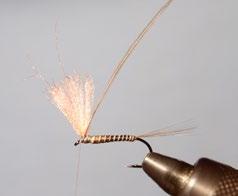


Tail: Hackle Fiber (Metz/blue dun) or Coq de Leon Hackle Fiber (Whiting/medium pardo)
STEP 1
Tie in some hackle fibers of Coq de Leon for tail (about 10~15 fibers).

Dubbing: Fly-Rite(light brown variant)
Parachute Post: TMC Aero Dry Wing (Fl Orange)
Tread: Uni Thread 8/0 (gray)
STEP 6
Choose an oversized hackle.
STEP 2 STEP 3 STEP 4 STEP 5
Prepare one nice length of hackle stem from Coq de Leon feather. Tie in the stem to the side of the hook shank. The shiny side (concave side of the feather) should be towards you.
Wrap around the stem, all the way down, to just behind the hook eye. Don’t fold back the stem, just bend it when winding.
Tie in two strands of aero dry wing for parachute post.
STEP 7 STEP 8 STEP 9 STEP 10
Tie hackle to the base of the parachute post.
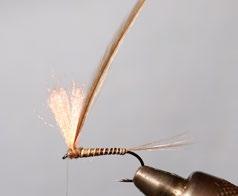


Take some FLY-RITE and dub it to the thread.
Make an abdomen and wrap around the hackle to the post from top to bottom Next step is the unique part of this fly.
No need to build up the para chute post.
Make the figure eight to divide hackle fibers from side to side, using para post and hook eye. Put some dubbing to the thread and make the head. Half hitch and whip finish. 37 International Masters of Fly Tying
Rediscovering Our Rivers
Fly fishing culture and conservation taking root near the Black Sea
Lado Sakvarelidze
The country of Georgia, located on the frontier of Europe and Asia, is what geographers and political scientists call a transcontinental country. The country sits within the Greater and Lesser Caucasus Ranges and between the Black and Caspian Seas. Its people have strong aspirations for their country to integrate with and join the European Union and to have closer political and economic ties

with the U.S. and U.K. Sadly, for those with such aspirations, there are other countries that do not support this idea. These actors want to keep Georgia under their sphere of influence. The matter is often a subject of debate on the world stage of geopolitics.

One thing nobody debates, however, is that Georgia has one of the most unique natural landscapes and cultures on our planet. Georgians are people of mountains and rivers.
Freedom of the hills
Locals joke that they are not famous for fishing on the sea because historically, Georgia was excluded from the Black Sea. We were often subject to conquest and domination by regional powers. The Classical Greeks, Persians, Mongols, Ottoman Turks, Safavid Iranians and Russians all exerted their influence over Georgians. However, the mountains and rivers always belonged to us. In those environs is where Georgians felt free and independent.
Fishing on rivers is a national tradition in Georgia. It is a popular outdoor activity, probably second only to running and hiking. Our rivers are not only rivers; we consider them masterful works of the Creator. They’re beautiful, stunning and offer no shortage of adventures— as do the natural landscapes that surround them. Many Georgians like to think that our national identity is blended into our rivers, mountains and landscapes.
Lado Sakvarelidze
FFI Member and founder of FFI’s International Affiliate club, Blue Rivers Club. Entrepreneur, New Born (Self Taught) Fly Fisherman & Environmental Enthusiast.
38 FlyFisher Spring/Summer 2022 CONSERVATION
Hard history
These rivers are historical habitat for four genetically-unique species of brown trout, however, in the wake of the collapse of the Soviet Union, Georgia experienced a tragic turn that was devastating for our native trout and the rivers and natural systems they inhabit. Like other neighbouring republics which experienced turmoil in the void of the stabilizing influence of the Soviet Bloc, Georgia entered a decade of political and military conflict, failure of state institutions and economic depression. Environmental mismanagement, pollution, industrial impact and illegal fishing resulted in fish populations plummeting in our rivers. Some research suggests that fisheries declined by an astonishing 80 per cent or more.
Scientists say that trout first occurred in fresh waters of Georgia two million years ago. That was when land emerged on this small corner of the planet, with the Caspian and Black Seas forming separately from the Mediterranean. River systems which connected the two seas were birthed. Ever since, unique genetic forms of brown trout have been spawning in these rivers, providing food and recreational opportunities for the communities that emerged on their banks.
Present priorities
Today, many of those communities— and communities across this country— are working hard to stop the decline of fresh water fish populations. They are aiming to restore healthy, historically-
typical populations of fish in these rivers, with the ultimate goal being the management of sustainable fisheries over the long-term. Local recreational fly fishing communities are on the front lines of this effort.
These communities are trying to raise awareness of recreational fishing values. They are also trying to advance arguments for correcting the current mismanagement of rivers and the elimination of poaching. The latter issue is most pressing, because unfortunately, some forms of illegal fishing (electrical, blasting) have for some people become a “recreational” pursuit. These people seem to be ignorant of the fact that such practices bring material environmental, social and economic damage.
More than 10 years ago, Georgian

39 Rediscovering Our Rivers Rediscovering Our Rivers
fly fisherman Shota Jokhadze formed a local club and helped organize an endemic trout breeding (hatchery) project. Today, Jokhadze runs an endemic trout population restoration project sponsored by the Georgia National Wildlife Agency. A few dozen fly fishermen assist him and a much larger group of spin fishermen are actively raising awareness about recreational fishing and catch and release culture.
Value added
I joined this conservation effort a year ago together with few friends, and it still amazes me that it was fly fishing that brought us here. We soon discovered the fun and pleasure fly fishing brings is about much more than just good fishing. Over time, we began to understand that protection and proper management of healthy rivers which support robust populations of fish not only helps ensure a much healthier environment for ourselves as we live and work, but that conservation also makes
our country a much more attractive place for tourism. Lastly, protecting these waters helps connect our rivers and mountains to our roots, heritage, values and hopes for the future.

A few months after we first took our fly rods in our hands, a friend and member of Fly Fishers International (FFI), Austin Kane from Atlanta, GA, recommended reaching out to FFI. To our delight, the organization responded with keen energy. FFI’s David Peterson, Tom Logan and Kuni Masuda extended a warm and welcoming invitation to join FFI, which we gladly did.
Catching the drift
At the same time, we coordinated a small campaign to encourage our government to open some of Georgia’s national park rivers for catch and release-based angling. The government received our proposal positively and suggested proceeding with a pilot project to evaluate whether such an initiative could give a strong boost to recreational fishing
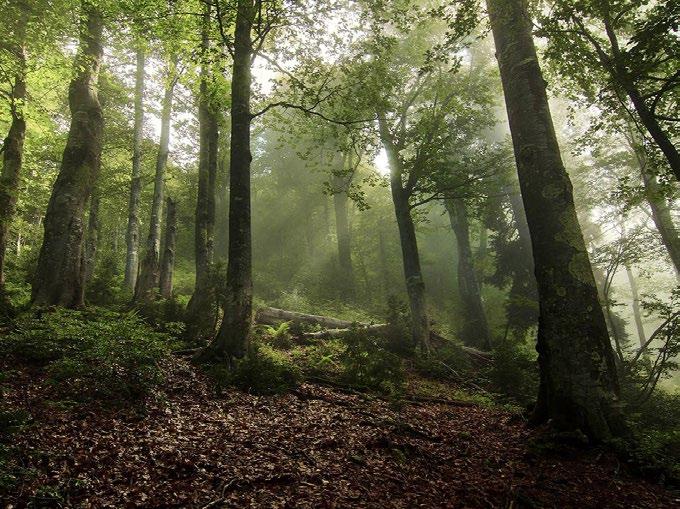
and promote a catch and release culture. The project was also intended to evaluate whether recreational fishing could generate an important revenue stream for local economies and whether it could help support Georgia’s management of fresh water fish populations.
We held a planning workshop with a local fly fishing club that has longadvocated initiatives such as those which we propose. We then held meetings with members of Georgia’s parliament and the heads of sports, environmental, agriculture and economic development committees. These meetings were arranged by MP Viktor Sanikidze, a supporter of outdoor recreation and former professional basketball player. Documents which presented the biological rationale, with economic considerations which justify our proposal, were prepared with assistance from FFI.
40 FlyFisher Spring/Summer 2022
Taking flight
The meetings were successful and the Agency of National Parks (Protected Territories) of Georgia has approved a pilot program to allowed fly fishing and spin fishing in Kintrishi National Park, on a 5 km-long portion of the Kintrishi River. That section of the Kintrishi River opened to fishing on January 1, 2022, requiring catch and release practices with barbless, single hooks and artificial lures/flies for catching native trout. Data will be collected to document the recreational fishing that occurs, evaluate any effect on the fishery and river and help serve as basis for expanding the project to other rivers and fisheries.


Our corps of fly fishers working on this initiative is now organizing a new non-for-profit entity, Blue Rivers Club, which will become an International Affiliate Club of FFI. The new organization will be
led by aspiring fly anglers; its goal will be to promote and advocate the conservation of clean rivers and healthy fish populations. The club’s primary focus will be fly fishing, but the group will promote sport fishing in general as a way to connect with and protect fish, wildlife and healthy natural landscapes, for benefit of all.
Future freshwater
Our intent, with the assistance of FFI, is to expand the presence and influence of fly fishing clubs, communities and institutions in Georgia and to continue working with our government agencies to implement more pilot projects in other national parks of our country. Additionally, we also will work to encourage municipalities and investors to create recreational fishing sanctuaries outside of national parks. These will be special river areas designated for
recreational fishing that will generate revenue to protect and manage rivers and fish populations. We hope this concept will eventually extend to the Black Sea territory. Our expectations in coming years are to see healthier waters, returning fish populations, more fly fishers (local and visitors) and all that goes with it: fly shops, cafés, clubs, schools, guides and new jobs with small businesses.
Soon, there will be more territories with good fish populations in our country and we hope to fish with other FFI members here in Georgia. And someday, perhaps, Georgians will be proud that our fishing culture extends to the Black Sea—or at least the fresh watersheds which surround it.
Lado Sakvarelidze
FFI Member Entrepreneur and New Born (Self Taught) Fly Fisherman & Environmental Enthusiast
41 Rediscovering Our Rivers CONSERVATION Rediscovering Our Rivers
Pause and Effect
Creep, drag and drift in between casting strokes
Jeff Wagner
Creep happens. When I teach casting to intermediate anglers, it’s rare that this topic doesn’t come up. Same thing with drag and drift. They’re common themes in fly casting instruction.
In this case, creep isn’t the way you approach spooky trout on a popular river in low water. Likewise, drift and drag in this context aren’t referring to how your fly floats through a run with multiple seams and currents. When we talk about these concepts as they relate to casting, we’re discussing movements of the fly rod which occur after the stop but before the next stroke—in other words, during the pause between casting strokes.
Creep’s a drag
Creep, as defined by FFI, is rod rotation during the pause in the direction of the next cast. Drag, according to our FFI friends, is hand translation (movement) during that same pause. Why do intermediate and advanced casters make these errors more than beginners? Because they have comprehended the basic casting stroke and are now looking for more power and distance. However, until
these students have understood and begun to eliminate creep and drag, they will have challenges extending their stroke length, developing more speed and carrying more line. Furthermore, until their rod and hand movements are identified and refined, all anglers will wrestle with keeping the path of the rod tip in a straight line.
Unwitting imperfections
Creep and drag, generally, are detrimental to the casting stroke, reducing the casting arc or casting length. Consider an angler making a 45-foot cast with good loops, using no less and no more movement than appropriate while ensuring a straight line path of the rod tip through acceleration. But then, after a back cast, there is an imperceptible forward rotation of the rod in anticipation of the next cast. Unwittingly, the angler has reduced the casting arc—gone from 10 and 2, to half past 11, so to speak. This is creep. Simultaneously, the angler’s arm fails to extend to the full stroke length. This is drag. Usually what happens next is the caster applies their power to a reduced casting arc,
the rod path dips and a tailing loop shows up.
Familiar foibles
It’s important to remember this is a common occurrence. Often, as a caster begins to increase their stroke length and arc and adds distance to their cast, the upshot of those resulting wider loops is a loss of feel with the fly line. As slack enters the system in the unrolling loop, in an effort to remain connected, they start creeping or dragging the hand in the direction of the cast. Similarly, as the caster carries more line, in anticipation of the next, more powerful stroke, the hand and rod creep forward.
Creep and drag are almost always linked. And no matter the level of angler expertise, the biomechanics of casting means there will always be some rotational and translational movement. Blame physics for that. However, the degree to which each movement happens varies and for our purposes, once we’ve identified the occurrence, we can work to minimize it. Here are some common fixes: Hold the position after the stop. The easiest, most immediate fix is to hold
Jeff Wagner
When he’s not fishing or casting you’ll find Jeff hiking or biking the back country with his family. They also volunteer their time to conservation efforts with groups such as Fly Fishers International. Oh, and during business hours Jeff does business stuff.

42 FlyFisher Spring/Summer 2022 CASTING
the position at the stop so that the casting arc is not reduced. Easier said than done, sure, but using vocal cues from an instructor or physical cues—a specific point or position in space—can aid in the process.
Increase the effective range of motion. Sometimes, the accidental introduction of creep can occur because a caster doesn’t have a full range of motion. Simple musclememory improvement exercises, such as practicing with a rod butt in front of a mirror, will assist with widening one’s stroke length.
Improve the loops. Tightening up one’s loops will reduce slack, improve feel and reduce the tendency to want to move that hand and rod forward.
Good with the bad
If you’re reading this as a tournament caster, you might be thinking that creep and drag aren’t always a bad thing. It’s true: creep and drag can both reduce slack before the next casting stroke begins. Used to pull in aerial, unrolled line, create a better connection with the system and even straighten the path of the rod tip, creep and drag can indeed be harnessed for good. But for the goals of most anglers, creep and drag are usually just that: a drag. To minimize them, my favourite remedy is to introduce drift.
Drift the drag away
Drift, once again as defined by our experts at FFI, is rotation and/or translation during the pause in the direction of the current cast. This differs from creep and drag, which occur during the pause in the direction of the next cast. Drift, generally, is utilized as a casting aid by instructors. Imagine a distance caster, accelerating smoothly,
their rod tip moving in a straight line and ending with an abrupt stop, forming a good loop in the backcast. But then, as the loop is unrolling, the caster smoothly rotates/translates in the direction of the unrolling loop, in such a manner that doesn’t introduce slack and before the loop has lost energy and begins to fall. Instead of reducing the potential arc and the length of the next casting stroke, the drift increases these elements, thus allowing for a longer application of power, a longer stroke and an easier cast. The uniformlyapplied power reduces the tendency of a wavering rod path and because the drift is introduced on the front or back cast, but not under power, it has minimal impact on the loop.
While it can seem a bit technical, it’s important to understand the movements of the drift in fly casting.
Rotational drift is rotation made in the direction of the current cast or unrolling loop. This is typically done by rotating the wrist or shoulder. This has been referred to as a “lay back” when done in the backcast, but it’s important not to lay it back too much. Over-drifting can pull the fly line down, increase the rate at which the loop unrolls and end the cast prematurely, the result of which robs you of power and reduces distance.
Translational drift is also made in the direction of the current cast or unrolling loop, but because it is made at the end of the cast where the arm is extended, typically as a lift, it is hard to achieve in isolation. Like an overextension of rotational drift, lifting too much can put tension on the line and cause it to unroll more rapidly.
Through the paces
To practice adding a drift and
minimizing creep and drag, start simple, without the burden of a full rod and reel set-up. Begin with just the butt of the rod, practicing in front of a mirror. Pantomime the casting stroke so you can watch the full motion of your cast without needing to turn your head. Make the “cast” slowly, then after the stop move the hand in the direction of what would be the unrolling loop.
Now, with an assembled rod and line, make the cast. After the stop, drift in the direction of the unrolling loop. The key is to practice it smooth and connected, as though your hand is being “pulled” by the unrolling loop. This means that no slack will be formed and will not pull on the fly line up or down or side to side.
With the drift made, it’s now critical to be sure you’re continuing to work on the range of motion. You will be applying power from a position that will be unfamiliar; this will generally take some time to manage efficiently. Practice the drift over a range of motion that is exaggerated so that your actual, effective stroke length and casting arc are easier to manage and control.
Advanced education
Casting creep is something that all fly anglers experience. Drag, too, occasionally drags all of our casting down. But drift—the kind that we achieve with our rod and arm position, rather than the quality of our fly presentation—can help mitigate these everyday errors.
Understanding the casting stroke on a deeper level means a greater understanding of your movements, why you are getting positive or negative results, and how to fix them.
43 Pause and Effect
Breaking on Through to the Other Side
Jerry Coviello
Have you ever stood in the water and wondered what the fish were taking? You see splashes on the surface, you see adult insects on the water and you respond by tying a dry fly on your leader. Simple, right? However, much to your consternation, even though you thought they’d be taking dries, all you’re getting is refusals! The answer may very well be that the fish are keying into a different, intermediate stage: the stage between a nymph/pupa and the adult mayfly/caddis fly: the emerger.
The emerger stage is where the insect is the most vulnerable. Stuck pushing through the surface of the lake or stream, the surface tension is the separation between two worlds: the aquatic and the terrestrial. That surface tension makes it hard for the insect to transition. During that struggle, when the emerging insect is most vulnerable, fish have that much more time to prey on them. Compare this to the quick- moving adult that can fly away from a hesitant trout.
How can we imitate that enticing emerger stage? To help break on through to the other side, I suggest trying the breakthrough patterns included here
This pattern imitates a multitude of mayflies or caddis flies. The CDC wing helps it float, while the deer hair wing looks like the wings coming to the surface, getting ready to complete the hatch. I like how, because of the CDC, you can see this pattern more easily in the film. The curved hook keeps the pheasant tail body under the surface and dually imitates a nymph or pupa trying to break out of its nymphal skin.
Pheasant Tail Emerger

Materials
Hook: Emerger Curved Hook
Thread: Brown 6/0
Tail: Pheasant tail fibers from a male pheasant Abdomen: Pheasant tail fiber
Rib: Copper wire
Underwing: CDC feathers
Overwing: Deer hair
Thorax: Brown dubbing or color to match hatch
Jerry Coviello
Jerry Coviello, a FFI Buz Buszek Fly Tying Award Recipient, serves as Fly Fishers International Fly Tying Group Chairperson and the Fly Tying Column Editor for Flyfisher Magazine. He is a columnist for Fly Tyer Magazine and the President and newsletter editor for Delaware Valley Fly Fishers. He is also an ambassador for Norvise.

44 FlyFisher Spring/Summer 2022 FLY TYING
The Moose Mane Emerger
This pattern has the body of the Mosquito Dry Fly, where dark and light moose mane hair is used to give the body a distinct, segmented look.
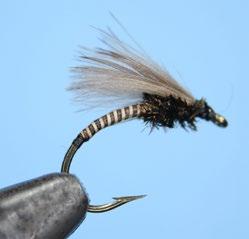
I like this fly in smaller sizes; it almost looks like a midge breaking though the surface. Again the CDC wing keeps it afloat and having a peacock herl thorax is a nice touch.
Materials
Hook: Emerger Curved Hook
Thread: 6/0 Black Wing: Dun CDC
Thorax: Peacock Herl
Body: Two strands of moose mane, one black and one white. Coated with head cement or Solarez Bone Dry UV Resin
Gary Lafontaine observed caddis flies underwater and saw the gas bubble that formed as the pupa rose to the surface. LaFontaine experimented with many materials, eventually setting on Antron yarn. Antron has a sparkling property, reflecting light naturally. The deer hair wing helps it float in the surface film. You can tie these in several colors and sizes.
Materials
Hook: Dry Fly Hook
Thread: 6/0 or 8/0
Tail: few strands of Antron yarn
Body Bubble: Antron yarn
LaFontaine Sparkle Caddis Emerger


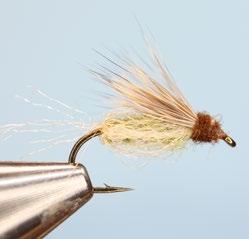
Body: Antron dubbing
Wing: Deer Hair
Head: Brown Antron dubbing.
Sparkle Dun
The Sparkle Dun was created by Craig Mathews by taking the comparadun and adding a tail of Antron or Zelon yarn. The resulting appearance is that of the adult still coming out of its nymphal shuck—a most vulnerable state. This is an excellent pattern for slow and flat-water where trout are feeding.
Just change the hook size and color to match the insect of the day
Materials
Hook: Dry fly hook
Thread: 6/0 or 8/0 to match the body
Tail: Antron or Zelon Yarn color to match the nymph
Body: Dubbing fur Wing: Fine deer hair. Compardun hair
This sounds like a Marvel Comic character and who knows? Someday it might just save your day. This fly is very simple to tie: there are only three materials other than the hook and thread. Developed by Craig Mathews to imitate a caddis fly that still has the nymphal shuck attached. This makes it a target, since the suggestion is the fly is in trouble and can’t take off right away.
Materials
Hook: Dry fly hook
Thread: 6/0 or 8/0 color to match the body
Wing: Elk Hair
X Caddis
Tail: Antron or Zelon to match the nymph color
Body: Dubbing fur to match insect
45 Breaking on Through to the Other Side
Hans Van Klinken created this fly to imitate an emerging caddisfly, with the body sitting below the surface while the parachute hackle floats it in the film. The hook is a curved hook, but the thorax area of the hook is flattened out to give it the appearance of a caddis escaping from its nymphal shuck. This fly has come up aces many times when nothing was hatching. It’s also handy as an indicator for a dry-dropper set up. You can use poly yarn for the wing, but I like the CDC feather as the wing post. If anything it provides more of




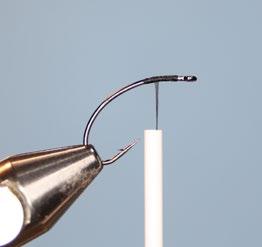
a challenge when tying a parachute hackle around the wing.
Material List

Hook: Klinkhammer Size: 12
Thread: Black 6/0 Body: Tan dubbing Thorax: Peacock Herl Wing: 2 Gray CDC Feathers Hackle: Dun hackle tied Parachute style
Step 1. Place hook in your vise.
Step 2. Take 2 CDC Dun-colored feathers. Align the tips. Measure them about half the hook shank length.
Step 3. Secure the wing at the midpoint of the flat part of the shank.

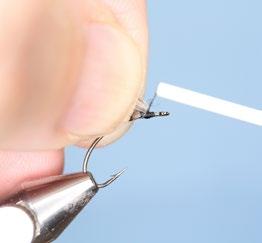

Step 4. Lift the wing up and wrap in front of the wing so it stands up. This is called a jam knot, or thread dam, in front of the wing.
Step 5. Make a dozen wraps around the base of the wing. This will help make a sturdy wing post to wrap your hackle around.
Step 6. Size a dry fly hackle. For a size 12 hook, I am using a hackle for a size 12 hook. Secure the hackle of the far side of the post. I will be wrapping the hackle towards me when I go around the post. I am securing the hackle to the wing post when done.


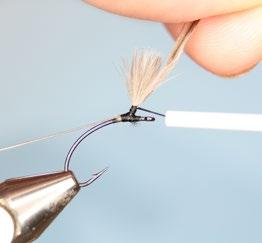
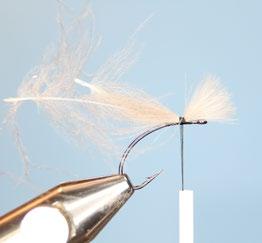
1 3a 7 2 4 8 2a 5 3 6 9 10 Here is the link for the Klinkhammer Tying Video https://youtu.be/weM4lVoocLM
46 FlyFisher Spring/Summer 2022
Klinkhammer Special
Step 7. Lift the hackle up along the wing post and secure the hackle to the wing post. Take a half dozen wraps around the hackle and wing post.
Step 8. Bring your thread to the bend of the hook. Your thread will be at a 30 degree angle at the point of the hook.
Step 9. Start dubbing the body. Taper as you get to the flat section of the hook, called the thorax.
Step 10. Finish the dubbing at the flat or straight section of the hook.
Step 11. Take 2 or 3 strands of peacock herl and secure them on the straight section of the hook.
Step 12. Twist the peacock herl to form a rope.
Step 13. Wrap the thorax with the peacock herl to the eye of the hook. Step 14. Wrap the peacock herl back to behind the wing.
Step 15. Tie off the peacock herl to the wing post.
Step 16. Cut the peacock herl leftover. Keep the thread in front of the wing.
Step 17. Wrap the hackle around the wing post, wrapping towards you when you go around the post.
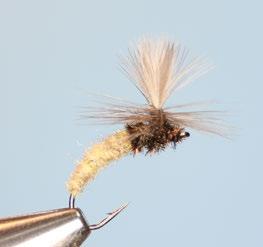
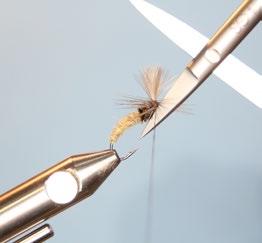
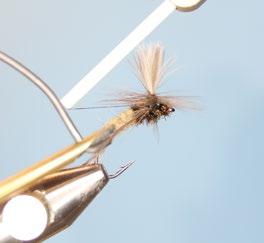


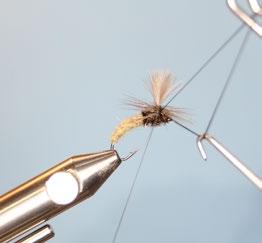


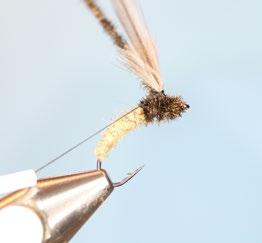
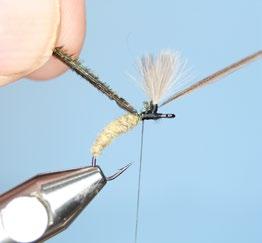
Step 18. Wrap your thread at the bottom of the wing post, catching the
hackle and securing it to the wing post.
Step 19. With the tips of your scissors, cut the hackle off.


Step 20. Whip-finish. Whip-finish under the hackles to the wing post.
Step 21. With the blade of your scissors, cut the thread. You can put a drop of head cement at the top base of the wing post where the hackles are wrapped.
Step 22. Klinkhammer Special completed. This can be tied in various colors and sizes. Change the wing to an orange color to see it better on the water.
11 15 19 12 16 20 13 17 14 21 22 18 47 FLY TYING Breaking on Through to the Other Side
FFI Learning Center Update
A myriad of new educational materials at your fingertips
Dutch Baughman
The Fly Fishers International Learning Center continues to grow.
Many new fly fishing skills, educational and instructional materials have been added to Learning Center website (www.flyfishersinternational. org/learn). The Learning Center features current videos, manuals, and slide presentations for casting, fly tying, fly fishing skills, and conservation.
Amongst all of the new fly fishing resources in the Learning Center is the new Saltwater Fly Tying Manual, as well as eight new casting instruction videos.
The Saltwater Fly Tying Manual was an initiative by the FFI Fly Tying Group to adhere to the “All Fish, All Waters” principle. Seven expert authors were assembled from around the country within Fly Fishers International to create a manual of 23 saltwater flies that could be used throughout the coastal
states. Each author supplied step-bystep instructions with photographs on how to tie the fly, plus background information about the pattern.
“The goal was to create a manual where tyers could download and learn the patterns and FFI clubs and councils could teach fly tying classes for saltwater patterns,” explained chair of the Fly Tying Group, Jerry Coviello.

Eight new instructional videos have been added to the Fly Casting Video Library. Master Casting Instructors Bruce Richards and Dok Arvanites teach practical fishing casts and techniques useful for minimizing drag, changing casting direction, casting heavy flies and sink tips, dealing with obstructions and stuck flies, and for managing fly line while casting and fishing.
“Learning these casts and fishing techniques will add to your enjoyment of fly fishing and will surely improve your catch rate,” said Ron Mayfield,
Dutch Baughman FFI Board of Directors & Education Committee Chair
FTG Board of Governors member.
Jim Sommercorn, who sits on the Casting Board of Governors subcommittee, helped review the fly casting skills development program and the production of eight new casting instruction videos, including Directional Change Casts; The Belgian Cast; The Roll Cast Pickup; How to Control Your Fly Line; The Reach Mend; The Curve Casts; How to Put Slack in Your Fly Line; and Off-Side Casting.
These eight new casting instruction videos will be added to the existing lineup, which includes the titles Pickup and Lay-Down Cast; False Cast; Roll Cast; Fundamentals of a Cast; and Resources Needed to Give a Class on Basic Fly Casting.
Many more new fly fishing educational and instructional material have either been recently uploaded to the FFI Learning Center or are in progress.
The FFI Fly Fishing Skills Program
48 FlyFisher Spring/Summer 2022 FLY TYING
is provided as a resource for individual fly fishers who pursue individual learning and participation in formal fly fishing skills workshops, or formal training as a FFI Fly Fishing Skills Instructor and includes four tiers for anglers to grow into:
Level 1: An opportunity for an individual fly fisher to explore, identify, and study fly fishing skills in the FFI Learning Center at their leisure;
Level 2: Fly Fishing Skills I: an opportunity for an individual fly fisher to participate in a formal Beginning Fly Fishing workshop during the FFI Virtual Expo;
Level 3: Fly Fishing Skills II: an opportunity for an individual fly fisher to participate in a formal Fly Fishing Skills workshop during the FFI Virtual Expo for experienced fly fishers.
Level 4: Fly Fishing Skills Instructor Development Program: an opportunity
for an individual to participate in a two day formal workshop designed to provide the teaching competencies in order to teach fly fishing skills (not connected to the Virtual Expo).
The Fly Fishers International Learning Center continues to grow. Our hope is that you will take advantage of the thought and energy put into creating the online resources so you can continue on your own journey of life long fly fishing learning.

49 FFI Learning Center Update
Ted Leeson, in The Habit of Rivers (1994) said, “The craft of angling is the catching of fish, but the art of angling is receptiveness to those connections, the art of letting one thing lead to another until, if only locally and momentarily, you realize some small completeness.”
This issue of Fly Fisher features articles that illustrate the personal fulfillment and enjoyment we derive from our sport beyond just catching fish. In that vein, I would ask that you join me in reflecting on the ways in which each of us finds joy in our sport and the part that Fly Fishers International plays in enriching our personal fly fishing journeys.
For me, the camaraderie and lifelong friendships gained over 37 years of fly fishing have more value than all the fish I’ve caught. I still fish with the same friends I began with, even though we live far away from one another. I’ve also been lucky enough to establish friendships with countless fly fishers who I would never have met if it weren’t for my membership in my local FFI club and my involvement with my council and the FFI Board. One pillar of FFI’s mission involves creating a “sense of community” among our members. I certainly hope that you have had experiences similar to mine and that FFI played some role in creating bonds with fellow fly fishers that have enriched your life.
Another source of joy is the immersion in the natural world that fly fishing brings us. Robert Traver

said the places we fish are, “invariably beautiful” and where we can “find solitude without loneliness.” Whether it’s sitting on the bank of a trout stream watching the water glide over multicolored pebbles, or experiencing the quiet beauty of a backcountry flat
at dawn, fly fishing takes us places that shape our lives and make each of us a conservationist. FFI, along with many other conservation-minded organizations, helps protect the opportunities we have to experience nature’s bounty and, as the author

Dave Peterson
Dave is currently Chairman of the Board of Fly Fishers International. He is a semi-retired school superintendent who fly fishes as often as he can. The Pere Marquette River in Michigan is his home water and he also fishes regularly in Montana, Maine, Florida and the Turks and Caicos Islands. He has served as Chairman of the FFI Conservation Committee and is a Life Member of FFI. He is also Conservation Vice President for the Great Lakes Council of FFI and a dedicated member of the West Michigan Hacklers, his local FFI charter club.
CHAIRMAN’S MESSAGE
50 FlyFisher Spring/Summer 2022
Jim Harrison said, be “drawn into the patterns and rhythms of the natural world.”
Perhaps you take your joy from tying the flies you fish with. If you do, you have enjoyed the satisfaction of creating a thing of beauty that successfully imitates life. Maybe you also teach others the art of fly tying. The joy of seeing the look on a young person’s face when they complete
their first fly is incomparable. If fly tying is your source of joy, our Learning Center and Fly Tying Group offer many ways to enhance your tying experience. There are more than 1,000 fly pattern videos in the Learning Center, as well as a remarkable new book (free to FFI members) for beginning fly tiers.
In closing, I want to share a quote from FFI member, and guide, Michael
Yelton. “A wise man told me once,” he said. “It’s not how many fish you catch, it’s where the fly fishing takes you in life.”
It is my hope that your fly fishing journey will be filled with joyful moments and that your membership in FFI has helped, in some small way, to create those moments.
Tight lines, Dave
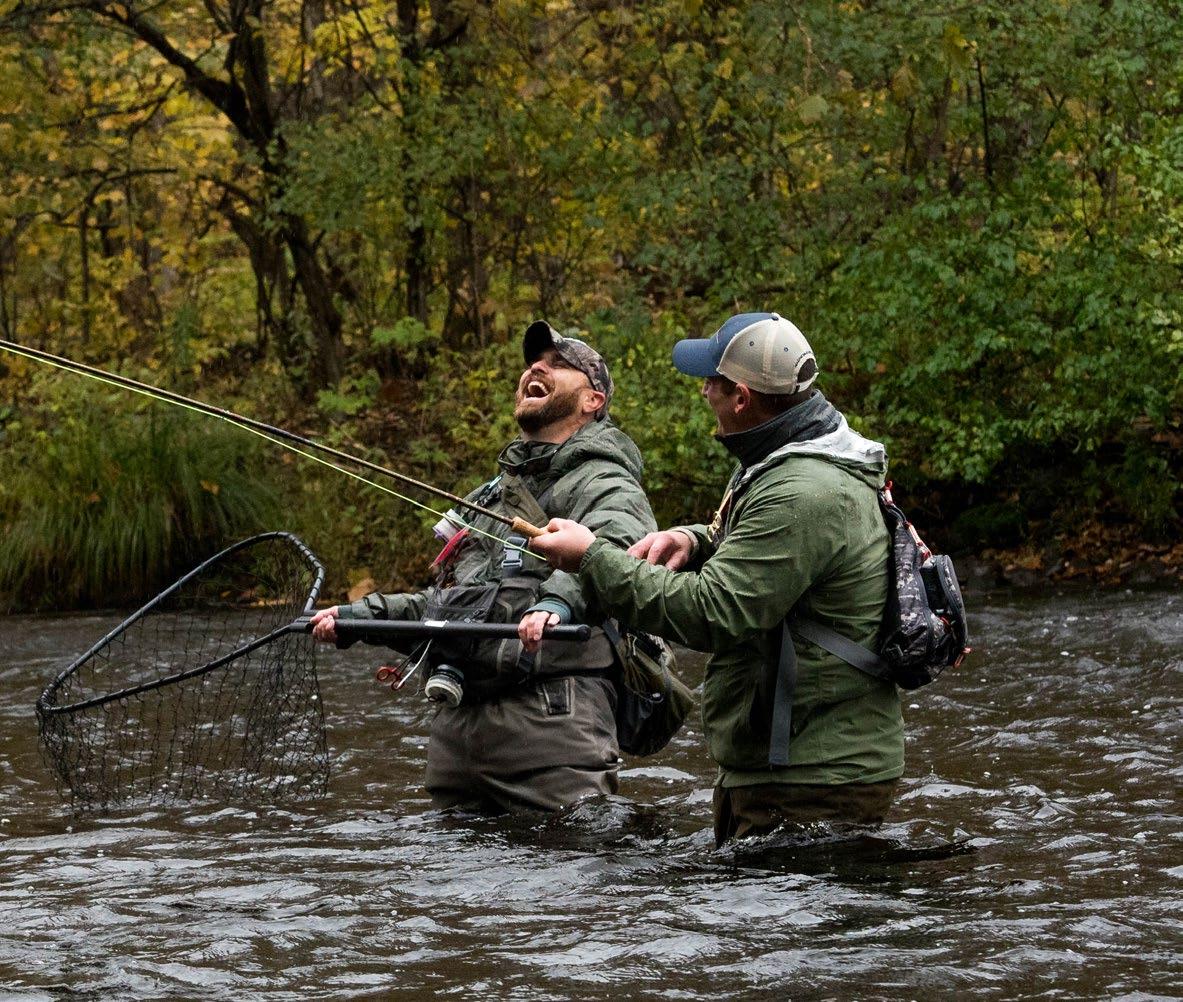
51 Chairman’s Message
Photo Lauren A Gramley
Greatest of All Time to be Memorialized in Bronze
To all who met him, Bernard “Lefty” Kreh was larger than life. He is known worldwide as a fly fisherman, conservationist, writer, and naturalist. In 2021 he was voted the “Greatest of All Time” by Fly Fisherman magazine and in 1991 the United State Postal Service released a stamp commemorating his world-famous fly, the “Lefty’s Deceiver.”
The Friends of Lefty Kreh (FOLK), a nonprofit 501c3, formed by the members of the Potomac Valley Fly Fishers (Lefty was a long-time member), was chartered by Fly Fishers International in December, 2021.

To celebrate Lefty’s life, the group is planning to erect a life-sized bronze statue of Lefty in peaceful Baker Park, in the city of Frederick, Maryland, where he was born, raised and began his rise to prominence. The location is just down the street from where Lefty grew up and adjacent to where Lefty graduated high school in 1942. The sculpture will feature Lefty in
action—fly rod in hand, wading in Culler Lake.
Renowned sculptor, Antonio Tobias (Toby) Mendez, has been commissioned for the work. Mr. Mendez has many works of public art displayed across the country, including the Thurgood Marshall Memorial, sports legends from famed Baltimore Oriole and Boston Red Sox teams, and B.B. King, among many others.
The fundraising has begun and the effort has already received a generous donation by the Ausherman
Foundation, so Mr. Mendez has begun the steps leading to the creation of the statue.
The Honorary Chairmen of this initiative are actor Michael Keaton, former news journalist Tom Brokaw, and fly-fishing author and fly creator, Bob Clouser; all avid fly fishermen and Friends of Lefty Kreh.
The Friends of Lefty Kreh invite you visit their website at http:// friendsofleftykreh.com to join the cause and contribute to the efforts of memorialize a legend.
Chesapeake (PA-WV-VA-MD-DE)
Eastern Rocky Mtn (WY-CO-NM-AZ)
Eastern Waters (NY-NJ)
Florida
Great Lakes(MI-IN)
Gulf Coast (LA-MS-AL)
Northern California (CA-NV-HI)
North Eastern (VT-NH-ME-MA-RI-CT)
Ohio
Oregon
South Eastern (KY-TN-NC-SC-GA-AL)
Southern (NE-IA-KS-MO-IL-OK-AR)
Southwest (CA-NV)
Texas
Upper Midwest (MN-WI-IL)
Washington (WA-AK)
Western Rocky Mtn (UT-ID-MT-ND-SD)
FFI FORUM
NH WA OR ID MT ND SD WY MN WI IA MO KS NE CO UT NV AZ NM TX OK AR TN IL IN KY MS AL GA SC NC NY PA RI DE NJ CT MD FL VT MI ME WV VA LA MI HI AK OH MA CA 52 FlyFisher Spring/Summer 2022
Photo Edwin Remsberg
2022 FFI Fly Tying Challenge
We are excited to announce that we are now accepting entries for the 3rd Annual FFI Fly Tying Challenge. Hosted by the Fly Tying Group, this challenge falls squarely with the groups mandate to preserve, enhance and support the art of fly tying as a historic element of the fly fishing experience.
In order to make the challenge accessible to all, regardless of skill level or age, we have identified 5 categories for entry along with a key pattern and materials list. We have found this serves to “level-theplaying-field” ensuring that judging is straightforward and skills-based.
Get your vise out and start practicing, entry deadline is September 16, 2022. Winners be announced at the FFI Virtual Expo in November, featured in both Fly Tyer Magazine and FlyFisher Magazine and will qualify for some sweet swag from NOR-VISE!
More information about the Fly Tying Challenge can be found online at flyfishersinteranational.org
Categories
Wet Fly Streamer



Craft Fur Streamer
Materials
Hook: Saltwater style hook Thread: 3/0 White Eyes: Living Eyes
Head: UV Flex Resin Body: Craft Fur and Flash of your choice
Nymph
Babcock Wet Fly
Materials
Hook: 1XL Wet Fly
Hook Size 12
Thread: Black 6/0 or 8/0
Tag: Fine flat gold tinsel Rib: Fine flat gold tinsel
Wolven Body Stonefly

Materials
Hook: 3 XL Nymph Hook Size 8 Thread: Brown 6/0
Tail: Brown Goose Biots Abdomen: Woven Body of Brown and Cream Color embroidery floss
Thorax: Tan Australian Possum egs: Pheasant Tail fibers Wingcase: Double folded Turkey Tail Antenna: Fibers from Turkey Tail Wingcase
Materials
Tail: Married duck, black over yellow Body: Crimson floss
Hackle: Black Hen Wing: Yellow duck with black stripe
Blue Dun
Hook: Dry Fly Hook Size 12
Thread: Grey 6/0 or 8/0
Tail: Dun Hackle Fibers
Body: Muskrat Grey Fur Hackle: Dun Hackle Wing: Mallard Wing Slips
PLUS Overall…where the entry must include all four categories listed and a tie-breaker fly of your choice!
Council Presidents:
Chesapeake Lane Thurgood lthurgood68@gmail.com
Eastern Rocky Mountain Tim Papich president.ermc.ffi@gmail.com
Eastern Waters Sam Decker samfishes@hvc.rr.com
Florida David Olson david@whitestackle.com
Great Lakes Terry Greiner tlgreiner12@gmail.com
Gulf Coast AJ Rosenbohm ajrosenbohm@gmail.com
North Eastern Jon Larrabee jon@larrabeereels.com
Northern California Mark Rockwell mrockwell1945@gmail.com
Ohio Jeff McElravy jmcelravysr@hotmail.com
Oregon Stephen Maher step.maher@gmail.com
Southeastern Debra Pauli president@secffi.org
Southern Chris Allen callenshooter@aol.com
Southwest Leigh Ann Swanson president@swcffi.org
Texas Rick Haness president@texascouncilffi.com
Upper Midwest Lyth Hartz lhartz@comcast.net
Washington State Steve Jones president@wscffi.org
Western Rocky Mountain Dave Londeree dlonderee@roadrunner.com
FFI Forum
Dry Fly 53
Reflections on Leadership and Engagement
Mark Rockwell, NCCFFI President
In my 20 years as a Norther California Council FFI member, I feel like I’ve seen it all. Hopefully my experience—all the good with all the bad—allows for some insights which could be helpful to future Council leadership in FFI.
After interacting with, and getting to know members of our many clubs, I believe the biggest challenge we all face is the simple reality of being an all-volunteer board. Working to accomplish the necessary tasks will always be difficult knowing members can leave without risk. Achieving desired outcomes, therefore, requires a group of dedicated people working together. It requires leadership—different leadership than that which is required to run a business, however. We have to be creative, offering volunteers choices that make them feel good about their job. What’s worked for our group is asking members to volunteer for the greater good of fly fishing, to work towards protecting our watersheds for future generations. We all must think beyond ourselves, our club and our Council. When people are dedicated to something bigger than themselves—making the planet a better place—they work harder and enjoy the process. They know they are working for a brighter future. This big idea must always be encapsulated in the goals and objectives of the Council to ensure people will participate and be engaged.
Another “must” is to create a strategy group within your board, with the responsibility of looking to the future and what the council needs to be doing, given the challenges both Council and clubs face. Remember: your primary customers are your clubs and their members. The strategy group should be made of a cross-section of board members who represent your different clubs. I’d suggest a group of five to seven people who have some board experience, who can focus on finding better ways of doing things.
Each year this group should spend two to three months working to craft the future goals and objectives for the Council, meeting two to three times a month. Included in this effort should be a review of your Mission and Vision statements, and Values. Work to establish a “doable” set of goals (four to six) that will take the Council forward into new and more inclusive contact with your clubs. Once you have the goals, define the action steps necessary to accomplish them. These action steps become the “work,” which the Board and Council will focus on for one or two years. Once the strategy group feels good about the plan, share it with the full Board. Take comments and edits, then ask for full Board approval.
The next major step is to get the members of the Board to take leadership responsibility for one of the Action Steps. Shared leadership is OK, but make sure they can work well together. Depending on Board size, you can have multiple “helpers” in each action step committee.
At this point, the job of the President is to oversee each committee, adding your advice and assistance to flesh-
out everything that needs to be done to do the job. The President should not tell the groups what to do. The groups need to develop each action step on their own. The purpose is for them to have ownership of both the process and the final product. The President guides and brings in help where needed. Lastly, you must have a deadline for completion, and when to begin implementation. This gives everyone an agreed to roadmap of the future. All that is left is taking it to the street.
Remember that clubs and members don’t want to feel left out, their needs forgotten. Regular communication and marketing to the clubs & members is critical. In our Council we do a monthly Club Presidents Happy Hour Zoom. These are done without an agenda, and are simply a time to get together, share the good and bad of life in a club. Successful clubs share what they’re doing to keep membership up and active, while clubs who are looking for more engagement discuss their hopes and needs. Our Club Presidents have said these get-togethers are the best thing we do. During the calls, we all realize we have similar issues to manage; people pitch in to help with problems, and they share with each other how to organize new activities. Over time, relationships develop between the Presidents. Club Presidents learn to rely on each other.
An additional action that has been a success is a monthly Council Report written by the Council President and delivered at the end of each month. Keep a spread sheet of club contacts and send it to club newsletter editors and webmasters. This allows you,
54 FlyFisher Spring/Summer 2022
the Council, to regularly tell your story to all club members. Why is this important? To put it in business terms: because your customers need to hear from you! Let them know you are working for them to make their club more successful.
The purpose of creating visionary goals, doable objectives and engaging actions is to deliver value to your
member clubs. The Club Presidents Happy Hour lets you find out what your clubs need. The strategy team develops the goals and action steps for the Council that are focused on the clubs. Your monthly club report allows you to remind them that you are working for them, and adding the value they want from FFI and the Council.
Lastly, always be open with everyone. Share with everyone what you are doing and why. Ensure that your goals and actions actually do make the world a better place, and improves the world of fly fishing. Create a tight community within your region with your clubs and its members. You’ll never regret it!

55 FFI Forum
Bob and Phyllis Tabbert Rick Williams
During this last year Fly Fishers International lost two cherished members, Bob and Phyllis Tabbert. Born in Wisconsin during the Great Depression, Bob and Phyllis exemplified both midwestern American and FFI values. They were humble, yet accomplished. They were passionate, yet quiet and courteous. They were genuinely interested in ideas, other people, fly fishing and conservation. And they generously gave their time and talents of to FFI—Phyllis through her donated quilts and Bob through his many years of conservation work and service as FFI’s Conservation Chairman ( 2009-2012 ), and later as a Senior Conservation Adviser. The Tabberts were extraordinary ambassadors of FFI.
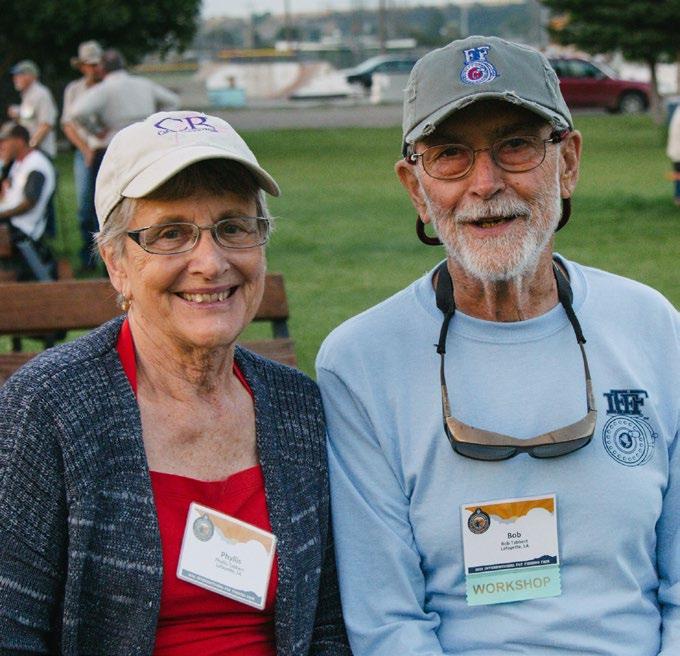
Bob and Phyllis were married for 68 years. Phyllis was a registered nurse, while Bob worked as an exploration geologist, a career that took him to remote portions of Alaska and Russia. Bob and Phyllis split time between their summer cabin in Lac du Flambeau, in northern Wisconsin and their southern Louisiana retreat in Lafayette. Phyllis loved hiking and birding, while Bob pursued protection of native brook trout. He pioneered a sampling collection for brook trout, hauling float tubes and canoes into remote spring ponds and collecting genetic samples by fly fishing. His efforts helped conserve native, genetic lineages of brook trout in Wisconsin. Bob (a certified Casting Instructor) also spent part of his winters chasing redfish and teaching fly casting with the
Acadiana Fly Fishers.
Bob was a Life Member in both FFI and Trout Unlimited. His greatest passion was to protect native trout in native habitats. Bob was a key member of FFI’s Conservation Committee; he helped craft many of FFI’s most important native fish conservation policies, including the Cuttcatch program. Bob’s conservation efforts were recognized by the prestigious FFI Conservation Award (2012) and the Don Harger Memorial Life Award (2012).
Verne Lemberg (FFI’s Conservation Chairman in the late 1990s) recalls Bob’s judgement and advice as always logical, always science based. Verne admired Bob’s tenacity to help native species in native waters, as well as his persuasive skills in working with public officials to generate interest and actions for
native trout. Tom Logan (current Conservation Chairman) remembers Bob as a strong collaborator and scientist whose perspective as a geologist aided our understanding of how natural systems developed over time.
I counted Bob Tabbert among my dearest FFI friends. I was blessed to know him. He was passionate about all things: FFI, conservation, fly fishing and casting instruction. He saw life as an essential and wondrous experience. His great curiosity and enthusiasm were infectious. He was a great storyteller; I never spent time around him without learning something new. I miss him dearly, but rejoice in he and Phyllis’s legacy of family, life and their commitment to conserving and protecting the beautiful world we live in—all things great and small.
56 FlyFisher Spring/Summer 2022 TRIBUTES
James “Jim” Schramm Keith Groty and Dave Peterson
FFI lost a true champion when Jim Schramm passed away on May 25, 2022. Jim was an outsized personality who, as FFI legal counsel for 30 years, left an indelible mark on FFI and its councils and clubs. He was also a passionate conservationist who tirelessly worked to preserve and protect rivers in Michigan and across the nation.
As FFI legal counsel for 30 years, Jim provided valued advice to the FFI Board of Directors as well as to its councils and clubs. He played a critical role in virtually every aspect of what Fly Fishers International has become. In recognition of his service, Jim received FFI’s Order of Lapis Lazuli (the highest award of distinction) in 2007, the FFI Conservation Award in 2001 and the Council Leadership Award in 2015. Jim was also a founding board member of the Anglers of the Au Sable in Michigan and the President of the Great Lakes Council of FFI for many years.
Leaving a legacy of conservation achievements, Jim was instrumental in forming the Michigan Hydro Relicensing Coalition (MHRC). This coalition has acted to remove dams and create meaningful environmental mitigation in waters across the state. The coalition is a key player in hydro relicensing agreements and played an important role in the removal of dams on the Boardman River in northern Michigan.
Jim also served on many fisheries advisory boards in Michigan. He
played a key role in establishing “catch and release, flies only” regulations on prime trout waters on both the Pere Marquette and AuSable Rivers. When Jim walked into a Fisheries Department meeting in Michigan everyone knew he was a force to be reckoned with.
Jim received many awards in recognition of his service and achievements in conservation and environmental work from FFI, Trout Unlimited, Anglers of the AuSable, the US Forest Service, the Michigan Department of Natural Resources, and the US Fish and Wildlife Service for his work on hydropower settlement agreements. He also received the Grayling Award for Protection of Aquatic Resources by the American Fisheries Society and was also awarded the 1996 Riverkeeper of the Year for his work on hydropower reform.
Prior to his legal career, Jim proudly served his country in the U.S. Army with distinction for over twenty years, retiring in 1984 as a Lieutenant Colonel. His service included tours of duty in Vietnam, Korea, and Germany. Jim received numerous citations during his service, including the Bronze Star for Valor while serving in Vietnam.
Jim married the love of his life, Dorothy, in 1993 and they enjoyed 29 argument free years together. Dorothy shared Jim’s passion for fly fishing and conservation and they were inseparable partners on the river and at FFI events.
Jim devoted himself to promoting and developing Fly Fishers International and made a lifelong commitment to the conservation of fish and their habitats. We all owe him a debt of gratitude. His legacy of good work on behalf of FFI will live on.

57 FFI Forum
FLY FISHERS INTERNATIONAL DONORS
We are proud to recognize donors who have donated $5200 or more. These funds help FFI continue our important work in conservation, education and as the voice of all fly fishers. These gifts may be dedicated by the donor to a cause they are passionate about.
PRESIDENT’S CLUB
The President’s Club at Fly Fishers International represents the highest level of financial commitment to the organization. Over the course of FFI’s history, the President’s Club has been instrumental in our ability to ensure the legacy of fly fishing for all fish in all waters.
PLATINUM $25,000+
Howe Foundation
Larry Gibbs
Keith Groty Robert Long
GOLD $15,000+
Ron Cordes
George Lane Charitable Trust
SILVER $10,000+
Anna Atkin
Glenn Erikson
Gary Grant
Great Lakes Council of FFI
Patty Lueken Patagonia Douglas Silver
YOT Full Circle Foundation
Jim & Dorothy Schramm
Sandra & Roger Miller Michael F Nolan Dave Peterson Bruce Williams
FFI 1000 STEWARDS
Richard & Mary Brown
Richard Diamond Brad Eaton
Robert Eck Lew & Tilda Evans Bud Frasca Thomas Gadacz Jack Gillis Don B. Gimbel Philip Greenlee
Carl & Maura Johnson Herb Kettler Kirei USA Edward G. Klaus Ron Knight Dean & Margaret Lewis
The Charles S. Lipke Trust Tom & Patti Logan
Andrew Reichardt Tom Sadler Scientific Anglers Fred Schmitz Michael Stewart Jonathan Walter Michael Webb Ron Winn Fred Schmitz Len & Dawn Zickler
We are looking for 1000 members and key stakeholders to join and pledge to contribute $500 per year for the next 5 years. The funds raised by the FFI1K are vital to providing a solid foundation on which to continue to grow and expand our mission and to support; spearheading projects that improve our fisheries and protect our fishing opportunities, the FFI Learning Center’s wealth of fly fishing knowledge and resources & the camaraderie among anglers that is built at our annual fair and other events.
Alpine Fly Fishers Club
Dutch Baughman
Paul Beckmann
Robert Bencic
Jean Black
James P. Bourgeois
Demetre Bove
Keith & Hillary Burkhart
Mark Cederwall

Alan Christy Davis
Clark-Skamania Flyfishers

Gary Cooney-Mesker
John & Kaki Crews
Thomas Cunningham
Alan Christy Davis
Robert E. Davis, II
Jeffrey Dean
David Drake
Eastern Waters Council of FFI
Reed Family Foundation
The Forrest Family Charitable Fund
Michael F. Gallavan Charitable Gift Fund
James Goedhart
Leonard Gruenberg
Todd Heggestad
Ralph K. Heide
Charles Higman
Patricia M. Jankowski
Carole Anne Katz
Bruce Kline
John Knight
Wayne Knight Frank Koterba
John R. Lewis
Dan E. Miller
Stewart Mitchell
Joseph Mizik
David Moore
The North Umpqua Foundation
John L Olson & Marilyn J Olson
Family Foundation
Overlake Fly Fishing Club
John Page
Thomas Patch Andy Payne David Perry
Bobbi Phelps Chapman Greg Pitts
Dennis Precourt Richard Ross
Robert Sales
Steve Schalla
Molly Semenik
Phil Shook
Dr. Sherman & Julie Shultz
Charitable Fund
Blayne Robert Smith
Joan Swartz
Bob Tabbert
Leonard Tavormina
The President’s Club at Fly Fishers International represents the highest level of financial commitment to the organization and comes with exclusive benefits and opportunities as a way of thanking donors for this level of generosity. Over the course of FFI’s history, the President’s Club has been instrumental in our ability to ensure the legacy of fly fishing for all fish in all waters. Members of the exclusive giving circle can support any program or project at FFI that most inspires them, and at a level that recognizes their level of giving, including Platinum, Gold, Silver, or Bronze.
Robert Tritsch
Upper Midwest Council of FFI
Steve Vedra
Washington Fly Fishing Club
Washington State Council of FFI
Estate of Bartlett D Whelton
Michael Willis
Michael Zahn
THANK YOU TO OUR GENEROUS SUPPORTERS
Join the Fly Fishers International flyfishersinternational.org/donate/presidents-club LEARN ABOUT JOINING operations@flyfishersinternational.org 406-222-9369 ext 4
Donor support has been key to our accomplishments – your generosity is making a difference. We’ve already started building on some of the accomplishments over the last couple years, a record of achievements worthy of reflection. So, what exactly have we done? We’ve created...

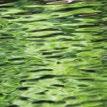

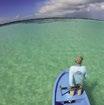


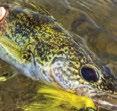




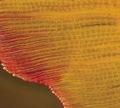




Thanks to everyone whose hard work made this possible. Looking
the future—we are excited about the direction we are heading
· a more diverse leadership · a dynamic brand refresh · a comprehensive learning center · a groundbreaking virtual expo · a thriving women connect program · a commitment to conservation · an enhanced membership experience flyfishersinternational.org @flyfishersinternational
toward
at FFI.
There is perhaps no more profound way to establish your legacy within the sport of fly fishing than by naming Fly Fishers International as a beneficiary in your estate plans.
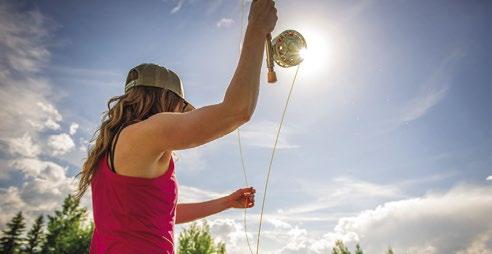

The FFI LEE AND JOAN WULFF LEGACY CIRCLE was established in 2019 as a way to honor the tremendous imprint Lee and Joan have left on the world of fly fishing, and the contributions they have made to Fly Fishers International.
And, if you have already included FFI in your estate plans, please let us know — we would like to honor your legacy and acknowledge your generosity that directly impacts on the future of fly fishing.
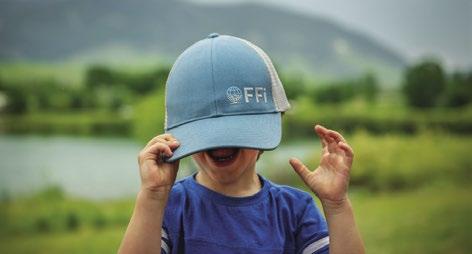

If you are interested in learning more about how to create your own legacy for the sport you love, simply contact FFI President and CEO, Patrick Berry.

WHAT’S YOUR LEGACY? THE FFI flyfishersinternational.org 406.222.9369 ESTABLISH YOUR LEGACY TODAY ///









